2022 Annual Report and Financial Statements

 The Jersey New Waterworks Company Limited
The Jersey New Waterworks Company Limited

Achievements



 The Jersey New Waterworks Company Limited
The Jersey New Waterworks Company Limited



Despite the operational challenges presented by the dry summer conditions, I am pleased to report that 2022 was a successful year for Jersey Water as we continued to deliver on our customer outcomes and strategic priorities. At 99.99% water quality compliance, the standard of our water supply remained very high, and we achieved our targets for leakage reduction. We also maintained our industryleading levels of customer service, achieving a customer satisfaction score (measured by the Institute of Customer Service) of 82.7%. Financially, the year was also successful thanks to an increase in water revenue of £414k, driven by strong demand for water over the summer.
As reported last year, we continued to focus on addressing the risks and challenges to the Island's water infrastructure in order to maintain the supply of high quality water on which Jersey depends. The need for resilience was reinforced this summer, with Jersey experiencing one of the driest years on record. This necessitated the longest operation of the desalination plant for many years, as well as the introduction of restrictions for the first time in two decades. We also remain conscious of the increasing effects of climate change on our business. Consequently, securing additional water resources remains a key strategic priority. In 2022, we made good progress on plans for further desalination capacity and water supply resilience. In the years ahead, significant investment in people, systems and infrastructure will be needed to enhance resilience and reduce the impact of climate related risks on our water supply.
The dry year and hot summer were also stark reminders that climate change is a real and present issue. We have been busy advancing our sustainability strategy, rolling out external training for all employees and baselining, for the first time, Jersey Water’s own carbon footprint. In 2023, we will publish our sustainability strategy, setting out how we will continue to support the Government of Jersey’s net-zero plans and play our role in protecting our island, community and planet for future generations.
We remain focused, too, on our people and property strategy. Following the sale of our head office at Westmount Road to make way for the planned Government of Jersey’s Our Hospital project, we relocated our corporate services team to a new head office in St Helier and secured temporary accommodation for our operational team in St Saviour. We also purchased a substantial property at Rue des Pres for £7,689k, earmarked to become our new headquarters once the building has been refurbished with a new laboratory, stores, workshops and offices. We aim to begin occupying this building during 2024, with the ultimate aim of relocating all our people under one roof. With the Rue du Pres site providing a more financially and operationally viable solution to our long term needs, we have chosen to discontinue our planned re - development of our Millbrook depot in Waterworks Valley.
At the AGM on 22 March 2023, we will say goodbye to Daragh McDermott. After seven years of service, Daragh is stepping down from our board to focus on his role as CEO of JT Group Limited. His valued contribution and insight will be missed. As part of the board’s succession planning, we are currently recruiting to fill two casual vacancies. In May 2022, our first board apprentice, Louise Clayson successfully completed her 12 month apprenticeship with Jersey Water under the Government of Jersey’s Inspiring Women into Leadership and Learning (I WILL) initiative. We have since taken on a new apprentice, Ioana Teslaru, who will start in January 2023.
On behalf of the board, I would like to thank everyone at Jersey Water, especially those who have risen to the challenges presented by the summer drought, all while maintaining an exceptionally high standard of customer service and delivering high quality water to our customers. I would also like to thank our customers, shareholders and stakeholders, as well as my fellow board colleagues, for their continued support.


 Helier Smith Chief Executive
Helier Smith Chief Executive
In 2022, the Jersey Water team has excelled itself, demonstrating once again the strength of our company culture, values and teamwork. Despite COVID-19, drought, water use restrictions and extended desalination, not to mention an office move, the whole team stepped up to maintain the high standards of service and supply on which we pride ourselves.
The financial results for the year were ahead of budget, showing a profit before tax of £6,765k, an improvement on the 2021 profit of £6,691k. 2021 results included an exceptional item of £4,015k profit on property sales, while the 2022 results include a fair value gain on derivative financial instruments of £1,364k and the net curtailment gain of £2,656k following the closure of our defined benefit pension scheme in the current year. Turnover increased by £436k to £18,792k, driven by a 2.4% increase in water revenue and a 2.0% increase in other income. Operating costs for the period increased by £520k or 3.5% to £15,458k. This was a result of upward pressure on the cost of procured goods and services and rental charges, offset by a reduction in people costs. Overall like for like profit before tax for the year was £2,745k, in line with the 2021 profit of £2,676k (ignoring the 2022 derivative and net curtailment gains, and the 2021 profit on sale of fixed assets).
Having refinanced our loan borrowings into a revolving credit facility (RCF) in 2021, and in anticipation of rising interest rates, we purchased an interest rate swap contract in May 2022 covering £7.5m of the RCF facility and fixing interest charges on that element for the next 10 years. At the year end, the derivative was valued at £1,364k, reflecting the benefit the derivative will bring over its life.
Capital expenditure for the year totalled £10,820k (2021: £3,051k), with the majority relating to the purchase, in support of our property strategy, of the new head office site in Rue des Pres. In addition, we extended the mains network by 0.9km, connecting 299 new properties, and renewed 1.9km of mains, reducing the risk of leakage and water quality complaints.
We remain conscious that our customers have no choice in their water supplier and as such deserve a high level of service. Our annual Institute of Customer Service (ICS) survey results showed the same high score as last year (82.7%), confirming that the quality of service we provide remains excellent. Despite the current cost of living crisis, we saw a slight increase in the proportion of customers who believe our charges represent value for money (74%, 2021: 72%) and those that find them affordable (73%, 2021: 72%). Water quality remained high at 99.99% compliance (2021: 100%), with fewer water quality related customer contacts than in 2021. The temperate weather during the winter meant that we experienced just seven burst mains (compared to 17 in 2021), enabling a 9.2% reduction in leakage for the year at 2.21Ml/d (in accordance with our leakage reduction targets) and zero customer minutes lost (compared to a UK average of 10 minutes).
This year was marked by low rainfall levels and a long, hot summer. Together, these factors necessitated the extended operation of the desalination plant from 1 August and the introduction of a temporary use ban from 26 August. The combined effects of desalination, the drought information campaign and temporary restrictions meant we ended the year with water resources at 65%, slightly below the 10 year average for the time of year. Modelling suggests that without these interventions, water resources would have reduced to 45%. Since the year end, water resources have recovered sufficiently for the temporary use ban to be lifted in midNovember and the desalination plant to be shut down. Despite the heavy rainfall in November, the long-range forecast currently suggests drier than average seasonal rainfall over the coming months. If groundwater levels are not restored, further restrictions may prove necessary over the spring and summer of 2023, coupled with further extended use of the desalination facility.

This year, we continued to implement our 2020 Water Resources and Drought Management Plan (WRDMP). We met our leakage target and continued to encourage water efficiency. We also made progress on developing additional desalination plant capacity, undertaking


The dry summer was a clear indicator of the potential impacts of climate change, which will become increasingly frequent and acute in the future.
various studies to inform the detailed design and operating philosophy for the new plant. Our next WRDMP is due for publication in 2025. In FY2023, we will begin updating our forecasts to take account of changes in population and the effects of climate change. In 2022, we began working with the Government of Jersey on the development of a Water Strategy for Jersey, designed to help us ensure that Jersey’s water supply is resilient to the effects of climate change and population growth in the decades to come.
To enhance skills and experience across the business, we continued our transformation programme within the water supply team. The programme concentrates on addressing skills, succession and resilience risks, and ensuring the team are best placed to address the water resource and quality challenges facing us in the future. The operating model has been successfully implemented within the water production and water network teams. During FY2023, we will focus on the technical support services, including the capital delivery, laboratory and asset management functions, ensuring they are resourced with the people, competencies and tools they need. This project is particularly important given the current challenges in recruiting candidates with the technical skills necessary to operate and maintain our assets.
Earlier this year, we completed a consultation process with members of the defined benefit section of the Jersey Water Pension Plan and closed the scheme to future accrual with effect from 1 January 2022. The 28 active members affected by the closure to future accrual were all migrated to our defined contribution pension scheme from that date. The trustees updated the plan’s investment strategy, focusing on reducing investment risk within the

plan and maintaining the ability to meet the scheme’s liabilities as they fall due. While the plan does have some small exposure to the changes in interest rates and movements in bond prices experienced over the past few months, it had no exposure to liability driven investment (LDI) derivatives during the year.

There is nothing more important than the safety of our employees. We work hard to provide our team with the training, equipment and working environment they need to operate safely. In 2022, we had no lost-time accidents, compared with two in 2021. In addition to routine site safety inspections, we issued new safety devices to our lone workers and updated our safety management system for disinfectant gas. Following an independent inspection by the British Safety Council, we received the maximum five-star rating in their Occupational Health and Safety Audit, confirming that we maintain best practice standards in our approach to safety management systems.
Though 2022 was arguably exceptional from a weather perspective, it was just one of many weather-related recordbreaking years in the past two decades. This suggests that we are watching the impact of climate change play out in real time. In light of Jersey Water's statement of purpose (“Supplying the water for our Island to thrive, today and every day”), the potential for increased disruption going forward is clear. As such, alongside our own sustainability initiatives to mitigate the effects of climate change, we continue to work hard on enhancing the resilience of the Island’s water supply in both the short and long term, investing to ensure a sustainable source of high quality water for our customers and community for years to come.
As we continue to pursue our goals, I remain indebted to everyone at Jersey Water for their hard work and support. I would also like to thank our customers and community members for their support and understanding during the drought. Their positive response to requests to reduce consumption have been nothing short of remarkable.



Our


We care internally for colleagues, externally for our customers and more widely for the environment we serve. We act thoughtfully and with kindness at all times.
Good is not enough and we are constantly seeking to improve, tackle challenges and demonstrate excellence. We are not afraid to innovate and take bold decisions that will benefit Jersey today and tomorrow.
We recognise the power, strength and solutions that come from teamwork, internally and externally. We work with our colleagues, our customers and our stakeholders, and are proud to be a partner for positive change.
In 2020, we developed four customer outcomes on which to focus our activities over the five years to 2025. The outcomes ensure that our customers are at the heart of everything we do.

We

We prioritise high standards of service, always. Our customers are unable to choose their water supplier, but if they could, we would want it to be us.
Every customer should feel that we offer good value for money and keep charges for water fair and affordable.

We have a responsibility to future generations for the decisions we make today. We strive to have a positive impact on the environment and Island community we serve.
Challenge ourselves to keep prices for water down while protecting our ability to invest for the future
Develop our company culture and remain a great place to work so that we can attract the necessary skills and talent Use technology to drive efficiency, improve service and build resilience Manage the risks that could challenge our business both now and in the future Work with stakeholders to deliver community and island benefit




In developing our plans, we are collaborative. We consider the needs of key stakeholders, ensuring we understand the environment in which we operate and the expectations of the community we serve.
Our customers and consumers are central to our business.
Without them, we would not exist.
We engage through face-to-face meetings, community events, online via our website and social media channels, and our annual customer survey.
We pay close attention to the customer feedback we receive (compliments and complaints), particularly the results of our ICS customer survey (see page 19).
We track UK water sector consumer groups and use their large-scale research to inform the position in Jersey.
Based on the feedback we get from our interactions with customers and wider industry research, we know that customers want:
• A reliable supply of high quality water
• Great customer service, getting things right first time
• Fair and affordable prices
• An environmentally conscious approach to the way we work
Our people are our most valuable asset, critical to our success. Investment in our people drives our culture and performance.
We have an inclusive and collaborative approach to working with our people, engaging with them to ensure their perspectives are considered in our decision making and planning whilst sharing our strategy and plans.
We undertake quarterly pulse surveys so that we can track engagement over time and seek views on topical issues. Employee feedback is tracked and actions followed up through our “You Said, We Did” tracker.
Our leadership team engage with employees face to face, both individually, in teams and within forums and workshops.
We use the feedback from employees to enhance our plans, ensuring that Jersey Water remains a great, safe place to work.
Our pulse surveys revealed:
• 95% agreed that Jersey Water was a great place to work
• 92.8% employees consider themselves to be engaged, empowered and effective A recent Investors in People survey indicated that:
• 77% felt appreciated for the work they do
• 87% feel encouraged to perform to the best of their abilities
• 76% feel they have a say in decisions that affect their role
Jersey Water was a finalist in the Overseas Employer of the Year: Silver Category in the 2022 Investors in People awards.
We have four customer outcomes to meet the needs of our customers (see page 9).
Our customer outcomes inform our business planning and are driven by targets and performance measures. Customer feedback and insights help us to shape our strategy and prioritise our plans and improvements.
Feedback from our employees is a key factor in determining how we run our organisation.
We replaced the annual town hall meeting with quarterly company updates. Feedback from our people confirms that they feel informed and updated.
We held our first post COVID-19, all company, in person, meeting at the Radisson Hotel on Thursday 29 September, where we launched our Business Plan for 2023.
We keep every employee aware of our plans and progress through several channels, including all company updates, toolbox talks, team meetings, one-to-ones and internal social media.
The health and wellbeing of our Island community relies to a great extent on a reliable supply of clean water. Meeting the wider needs of the community and its interest groups is critical to our long term success.
We have regular and ongoing dialogue with special interest groups in Jersey to develop our understanding of emerging or topical areas of concern.
We participate in numerous forums both locally and in the UK to understand the latest thinking and industry perspectives on community and societal matters.
We provide public services that are essential to island life. The key to our success is engagement with the Government of Jersey in its capacity as regulator and provider of other public services.
We have a collaborative and transparent relationship with the environmental regulator and government (in its non-regulatory capacity) whereby we work together to address the risks that threaten our success.
Our feedback and research indicate that, as a water supplier providing a vital public service, we are subject to certain expectations. We have a duty to act for the good not just for our customers, but wider society as well.
Local stakeholder groups tell us that we have a role to play in protecting the environment and playing a positive role in the community.
Through our purpose statement, we recognise our wider community role and responsibility. This purpose drives our customer outcomes and strategic objectives.
We work both alone and in partnership with other stakeholders to deliver community and environmental benefits for Jersey.
We aim to contribute through a wide range of initiatives (see pages 22 and 23 for more detail).
We have an ongoing and open relationship with our regulators and other government departments, who expect that we will operate on a transparent, ‘no surprises’ basis. There is the understanding that we will play a leading role in matters relating to the Island’s public water supply.
Through partnerships with other stakeholder groups, we play an instrumental role in addressing serious, water related issues affecting our island, including:
• Promoting the need for an Island Water Strategy within the Bridging Island Plan to address Jersey’s forecast water supply deficit
• Working with the Action for Cleaner Water Group to improve water quality in our catchments
• Working with the PFAS Technical Officer Group to resolve the PFAS pollution issue in St Ouen’s Bay and Pont Marquet
• Consultation with key stakeholders on our plans to address the long term water shortages identified in our Water Resource and Drought Management Plan
Meeting the needs of our investors ensures that the business remains successful over the long term, which in turn meets the needs of our stakeholders.
We meet with our majority shareholder biannually to discuss performance, strategy and other matters. We also engage informally as and when required.
Our AGM gives the Board the opportunity to engage with our shareholders, answer questions and receive feedback.
Our annual report and financial statements provide a transparent and comprehensive review of the our financial and operational performance.
We engage with other providers of finance (i.e. banks) on an ad hoc basis to keep them informed of our performance and plans.
Discussions with our majority shareholder continue throughout the year. Dialogue centres around:
• Our ongoing financial performance
• The way we mitigate risk and resolve issues
• The focus on cost efficiency whilst maintaining a high standard of service and resilience to the island community
• The standards of governance to which we operate
To ensure transparency and openness, our financial reporting exceeds the level of disclosure required for companies the size of Jersey Water. New reporting includes enhanced disclosures around:
• Movement in principal risks and uncertainties
• Sustainability
• Updated strategic review to include actual versus target performance for the year
• Updated governance disclosure
Our corporate governance framework operates at the standards required of the UK Corporate Governance Code.
Why do we focus on these stakeholders? How do we engage them?
Why do we focus on these stakeholders? How do we engage them? What do they tell us?
Why do we focus on these stakeholders? How do we engage them? What do they tell us?
How do we respond to them?
Delivered a reduction in the number of customer contacts related to the appearance of water supplied for the 4th consecutive year Developed the catchment operating philosophy for the selection and blending of raw water sources to safeguard water quality and quantity Delivered the chemical dosing and filter improvement projects at Handois Water Treatment works
Completed a feasibility study into the extension of the desalination plant to increase production capacity and improve drought resilience

Delivered the critical elements of our Network Improvement Strategy to achieve our stretching 5-year leakage targets
Further reduced the number of customer supply interruptions
Progression of our Water Resilience Framework and Water Resources and Drought Management Plan to identify and reduce risks to water quality, improving resilience and securing drinking water supply for the island
Progression of the detailed design for the La Rosière Desalination Plant extension to ensure it is a reliable drought contingency source
Improved water quality governance through the review of our Water Resilience Framework and drinking water safety plans to identify and manage water quality risks
Further development of the PFAS strategy with the States and Ports of Jersey to address the Island's pollution issue
Continued implementation of the Network Improvement Strategy aimed at further reducing leakage to address water resource shortages
Completion of the pilot trial introducing Smart Metering technology with automated meter reading system and a customer app
We have been delivering safe, high quality water to Islanders for 140 years. This year, our supply continued to be of excellent quality, with 99.99% of samples meeting the requirements of the Water (Jersey) Law 1972. To monitor this performance, we completed 12,000 sampling tests on untreated water from streams, storage reservoirs, and the inlet to our treatment works. In addition, 14,867 laboratory tests were taken on treated water from our water treatment works or the mains network. Of these, two samples were outside the respective regulatory parameter but they posed no significant risk to health. Both were reported to the environmental regulator who were happy with our investigations and actions taken.
For the fourth consecutive year, significantly fewer customers contacted Jersey Water regarding the acceptability of their drinking water, with just 65 contacts received in 2022 – nearly half the number of contacts received in 2021 (122 contacts). The majority of these concerns were regarding the colour, taste and odour of the drinking water and the number of contacts remains significantly below the industry average for England and Wales.
In 2022, Jersey Water commenced a collaborative research project with Cardiff and Bath Universities. The goal of this project is to better understand how to manage algae blooms in our raw water storage reservoirs. The project, which includes the innovative use of eDNA sampling to identify and monitor algae species in the water, will help to further minimise the risks of adverse taste and odours, which algae can cause.
As part of the Action for Cleaner Water Group (AFCW), we continue to work closely with the Government of Jersey and the farming community, delivering water quality improvements and protecting the catchment from pollution risks. To protect our water sources, we undertake proactive catchment management, using technology to monitor raw water quality. For the ninth consecutive year, we have successfully treated and maintained nitrate concentrations below the regulatory limit in drinking water. Water quality was also fully compliant with limits for pesticides for the sixth year in a row.
We are collaborating with the Government of Jersey Technical Officer Group investigating the issue of PFAS pollution in the vicinity of the airport within the St Ouen’s Bay aquifer and Pont Marquet catchment. The aquifer in St Ouen’s Bay and the Pont Marquet catchment are important water sources for Jersey. Their pollution with PFAS presents a significant raw water quality challenge which inhibits their use and our ability to extract water from them. Although the PFAS levels are effectively managed through raw water blending
and treatment, a holistic solution must be found to address the pollution issue for the Island to address the current and future water quality risks presented by PFAS.
To manage the current water quality risk, we monitor the level of PFAS at the treatment works and in the affected water sources through an extensive sampling and analysis programme. The results of our testing provide assurance that the drinking water supply in Jersey remains fully compliant with water quality limits for PFAS set by the EU Drinking Water Directive and UK regulations.

To find a potential solution to the PFAS problem, our Production and Technical teams continue to work with a leading remediation specialist to carry out pilotplant studies to assess the effectiveness of an up-and-coming treatment technology known as SAFF (Surface Active Foam Fractionation). Treatment trials were undertaken using a benchtop pilot plant to quantify the percentage removal of PFAS substances from the raw water sources. Jersey Water will continue to work closely with the Government of Jersey Technical Officer Group to identify potential treatment solutions for PFAS in drinking water should they be required in the future.
Our water supplies are provided by an integrated water resource system comprising of reservoirs and stream abstractions, groundwater boreholes and La Rosière Desalination Plant.
We currently supply an average of 18.7 million litres of water per day via our water treatment and network system to some 37,000 homes and 3,600 commercial properties across Jersey.
It is estimated that, due to assumptions on population growth and the impacts of climate change, the water demand for the island under dry weather conditions will increase by 15% from around 21 million litres per day in 2019-2020 to nearly 24 million litres in 2045.
In 2022, although we experienced a reduction in average yearly water demand of 3.2%, the Island experienced a warm summer, leading into a dry autumn, experiencing below-average rainfall. The Island received just 795 mm of rain, a significant decrease of 334mm compared to the previous year, resulting in depleted raw water storage levels. The Island officially entered a drought period in July, with the desalination plant producing a total output of approximately 650 million litres (to the end of November) to supplement water supplies. In addition, a temporary use ban was introduced on 27 August and remained in place until November to help raw water storage levels recover until wetter autumn and winter weather arrived.
The 2022 drought across the UK and much of Europe has underscored the need to improve water supply resilience outlined in our Water Resources and Drought Management Plan. The recommendations outlined in the plan address the supply deficit over the
25-year planning period by implementing a balanced portfolio of demand management measures, water source enhancements to increase supply, and further water efficiency measures. We made significant progress in 2022, delivering several key outcomes outlined in the plan, including:
• targeted catchment protection initiatives to improve water quality and protect valuable raw water sources from pollution and algal blooms
• work with Government to agree on the potential solutions to address the historic PFAS pollution in the St Ouen’s and Pont Marquet catchment
• progress with the feasibility study to increase the production capacity of the La Rosière Desalination Plant
• ongoing achievement of the challenging 5-year leakage targets

• robust drought contingency planning outlining temporary water restrictions for customers in severe drought to achieve 1 Ml/d of demand savings
To improve and secure the future resilience of Jersey’s water supply, we will continue to work to deliver the outputs detailed in the Water Resources Management Plan that are acceptable and affordable for our customers.
In 2022 the Asset Management team began developing the Water Resilience Framework (WRF) for Jersey Water to inform resilient decision making to understand and avoid the shocks and stresses the changing environment can potentially have on the Island's water supply system that may make it vulnerable. As such, the WRF is a method used, either individually or collectively, alongside the existing Water Resource and Drought Management Plan to gain insight into how we plan, invest and measure progress towards building long term water resilience for the Island community.

In 2022, our operations team successfully delivered several enhancement and maintenance projects to improve resilience, reliability and water quality.
As part of our water resilience planning, we finalised the engineering-feasibility study to increase the production capacity of the La Rosière Desalination Plant to ensure we can meet the future water demand for the Island in severe drought conditions. This year’s drought has reinforced the importance of this critical asset as a contingency for Jersey. Plant expansion therefore remains a high priority. To meet the recommendations outlined in the Water Resources Management Plan, the final construction and commissioning of an additional capacity membrane works is scheduled for 2025-2026.
This year, we worked with specialist membrane engineering consultants to complete several engineering studies. These studies assessed the capability of the existing membrane plant to provide the maximum treated water flows in a severe drought scenario. Hydraulic capacity testing assessed the feasibility of utilising as much of the existing plant as possible to provide the required increase in production flows. Extensive water quality modelling explored the impact on water quality of increasing the volume of desalinated water blending into Val de la Mare Reservoir. This work identified the process chemistry improvements needed to ensure that increased production flows at the desalination plant have no adverse effects on the quality of water supplied to customers. Further water quality impact assessments identified the plant modifications required to protect the marine environment from the effluent discharges of the membrane treatment process.
As part of our asset investment plans to improve water quality, we designed, installed and commissioned the Westmount Service Reservoir kiosk
in September 2022. This engineering project involved installing improved flow-level, temperature and chlorineresidual monitoring to improve the disinfection efficiency of the service reservoir. The project delivery team utilised an engineering approach known as DfMA (Design for Manufacture and Assembly). This involves designing, manufacturing, and assembling the plant as a modular package built to water industry standards. The plant arrives at the site ready to be installed and commissioned into supply by our operations and engineering team. This engineering approach reduces plant assembly time, costs, and complexities by minimising the number of individual parts, assembly steps, and potential for variability in build quality.
We rolled out further asset improvement work at Handois Water Treatment Works, refurbishing the filter-back washing pumps to improve the performance of the filtration process. This work, combined with plans to improve the chemical dosing plant, will improve resilience and the effective operation of the treatment processes to enhance water quality performance.
During 2022, as part of our Network Improvement Plans, we focused on delivering improved service to our customers by introducing enhanced working practices and new technology, as well as by investing in our network infrastructure. We have improved the way we monitor and optimise the performance of our water network to reduce leakage levels and minimise the number of customer supply interruptions while improving water quality and encouraging water efficiency. Installing remote monitoring devices in the network has enhanced our ability to detect system leakage and locate and repair main bursts quickly. Thanks to these and other improvements, and despite an exceptionally hot summer in which leakage figures rose to over 3.0 MLD, we successfully reduced the level of
leakage to 2.149 MLD, beating the target of 2.2165 MLD. As such, we continue to perform better for leakage than the UK.
Over the last year, we have systematically made improvements to our network boundaries, installing new by-passes and valves, making it easier to isolate parts of the network. This has enabled us to keep our customers supplied with drinking water while repairing leaks and installing new mains. As a result, we have reduced the frequency and length of customer supply interruptions, outperforming the previous year’s performance for customer minutes lost (CML). The CML measure records any disruption to a customer’s drinking water supply that takes longer than three hours to rectify due to a failure of, or work being carried out on, the network. Our performance for this measure continues to outperform the UK water sector.
In 2022, we embarked on a Smart Metering trial, installing intelligent water meters in selected parts of our network. The proof-of-concept trial will continue throughout 2023. If cost beneficial, the Smart Metering Programme will be rolled out, installing intelligent meters across most of the Island’s network system. A successful outcome of the trial will enable remote automated meter reads and improved data and information, delivering several customer benefits, including:
• the early detection of customer side leakage
• greater accuracy and ease of detection of network leakage
• consumption data available on a customer app
• improved accuracy and information on water consumption and usage
• improved customer billing information
At Jersey Water, we have been a member of the Institute of Customer Service (ICS) since 2017. In partnership with ICS, we complete an annual independent customer satisfaction benchmarking survey to compare ourselves to other companies in the UK.

The three key metrics of this survey are the Customer Satisfaction Index, our Net Promoter Score (how many people would recommend Jersey Water) and Customer Effort (how much effort did a given customer have to make to complete their transaction). ICS benchmarked our scores against the UK Customer Satisfaction Index (UKCSI), which is published twice yearly
For the fifth consecutive year, we performed well above the UK all-sector and utilities averages across all metrics, as shown in the tables on page 19. We maintained our Customer Satisfaction score of 82.7%, with our customer effort score reducing slightly by 0.1 points (meaning we became easier to do business with).
these
Our in-house text feedback service scored 9.08 out of ten, slightly up on the prior year’s score of 8.75 and our target of 9.0.
Maintaining our
trust and satisfaction is an essential part of being the sole provider of water in Jersey. To achieve this we commit to delivering a high stand of services measured by stretching key performance indicators and external benchmarks, designed to challenge us to do better each year.
These results confirm that customers are satisfied with the service they receive and would recommend us if there were alternate providers.
An area for potential improvement is our “right first time” score. At 66.4%, this is slightly down on our prior year score, and below target. Analysis showed that this score was influenced by the score from a small number of customers surveyed who experienced a problem or made a complaint.
Overall, complaints remained low and reduced over the year. All complaints are subject to investigation to better understand what went wrong and how changes can be implemented to reduce the likelihood of reoccurrence. The feedback contained within the ICS survey helps us to target improvements where the most customer frustration is experienced. In this light, any complaint is an opportunity to improve our service or communication.
Our focus for 2023 is to embed new processes from the improvements to our billing system, which are helping us to reduce the time we spend on manual high-frequency tasks and ultimately deliver greater customer service efficiency. We will also focus on improving processes which can impact the customer’s experience of “right first time” when raising a query or concern with us.
UKCSI all-sector average
UKCSI all-sector average utilities
Jersey Water Business Benchmarking 2022
(UKCSI)
45 50 55 60 65 70 75 80 85 90 95 100
UKCSI July 2022 data sourced from nationwide ICS survey panel of 10,000 customers. Our Business Benchmarking survey data based on respondents from our customer survey. The results are generated from a total of 435 customer respondents.1
UKCSI all-sector average
UKCSI all-sector average utilities
Jersey Water Business Benchmarking 2022
Jersey Water Business Benchmarking 2021
Jersey Water Business Benchmarking 2021 -10 0 10 20 30 40 50 60 70 27.9 39.7 43.1
3.6
Net Promoter Score (NPS) is based on ‘likelihood to recommend’ scores. % of respondents scoring 9 or 10 (out of 10) on likelihood to recommend minus % of respondents scoring 0-6 on likelihood to recommend equals NPS1
UKCSI all-sector average
UKCSI all-sector average utilities
Jersey Water Business Benchmarking 2022
0 1 2 3 4 5 6 7 8 9 10 5.3 5.6 2.8 2.9

Customer Effort is based on the question: ‘How much effort did you have to make to complete your transaction, enquiry or request on this occasion’ (1-10 scale). A lower score signifies less effort required on the part of the customer.1
1 Survey data as provided by the ICS.

In our annual ICS survey, we collect input from customers on the affordability and value we provide. With the cost of living currently rising, we anticipated a decrease in these scores. In fact, the average value for money score for 2022 increased by 0.2 points to 7.4 out of 10. The affordability score was 7.3, 0.1 points higher than in 2021.
To ensure our water stays affordable, we have historically limited price increases to at or below inflation. This policy has been successfully applied in all but two of the previous 20 years. Adjusting for the effects of inflation, the price of water has decreased in real terms by 19.3% over that period thanks to our commitment to cost efficiency.


As the costs of energy, raw materials, labour, transport, and financing all rise, so does the cost of providing our service. There is also upward cost pressure from the investment necessary to advance our strategic plan and address key risks (such as the impact of climate change/ drought, skills shortage and succession, and cyber resilience) while encouraging our customers to use our product less. In balancing these factors we are also determined to recognise the pressure being placed on household budgets by the current high rates of inflation in our tariff consideration. We did this by limiting the cost increases passed on to the customer in 2023, keeping our tariff increase below the most recent retail price index (RPI) and maintaining the 10-year real-term price decrease.
In October, we announced that water charges will increase by 6.0% from January 2023 to accommodate rising service costs and support our current business plan. This increase is below the RPI against which our tariffs are benchmarked, which stood at 7.9% in June 2022.
Looking ahead, we remain committed to balancing the need to minimise increases in water charges with the need to continue to invest in the island’s watersupply infrastructure and address the risks listed on pages 31-33.

Price of water
Inflation adjusted 2011 price

After a two-year hiatus, we are thrilled to be back in the community with our Hydration Stations at local events such as The Boat Show, Out-There Music Festival and The Weekender, providing free water for thirsty festival goers and raising money for Dementia Jersey through the sale of reusable water bottles. We raised £17,000, which will help the Dementia Jersey team improve services for people with dementia and those who care for them.
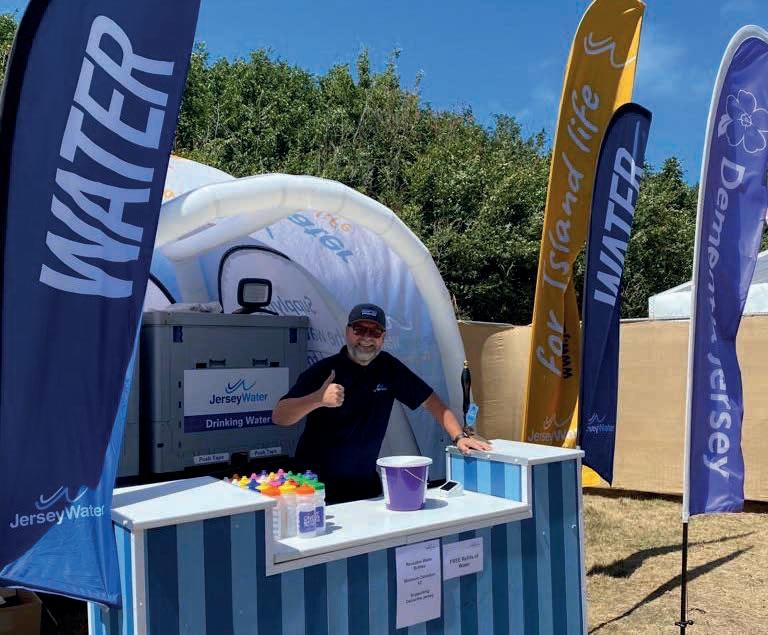
Jersey Water employees have chosen to support Teenage Cancer Trust in 2023. The charity makes sure young people in Jersey do not face cancer alone. They do this by providing funds which enable world-class cancer care and support in the specialist unit at Southampton Hospital and Jersey Hospital.
In 2022, we continued to partner with key stakeholders to help protect the environment. To inspire young people to protect Jersey’s water sources, on World Ocean Day in June, we collaborated with Ocean Culture Life
and the Government of Jersey IHE Blue Fish Campaign to deliver a series of educational workshops, virtually and in person. We aimed to raise awareness of how precious water is – whether in the ocean, reservoirs, streams or drains –and why it must not be polluted.
We also welcomed our first school group to our Water Treatment Works at Handois Reservoir since the pandemic. Year 4 from Les Landes School learned all about the treatment process and how much work goes on behind the scenes to make water safe to drink.
In addition to our ongoing sponsorship of the National Trust for Jersey –in particular, their Annual Walking Programme and two Walking Festivals – we have developed a new partnership with Forest Friends. This organisation offers outdoor sessions designed to educate children and their parents about the natural world. This is child-led and play-based learning at its best, so we’re delighted that Forest Friends can use our land at Grève de Lecq to deliver their sessions.





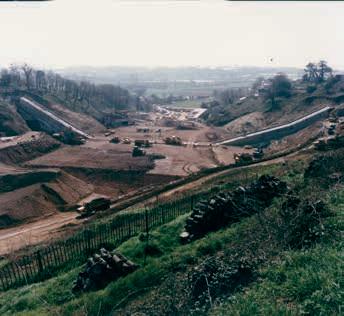



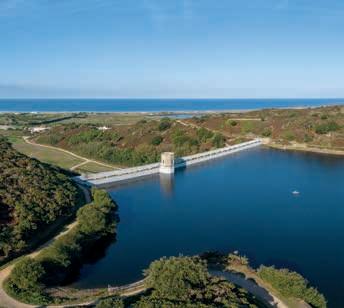











This year we celebrate our 140th anniversary since our incorporation in 1882.







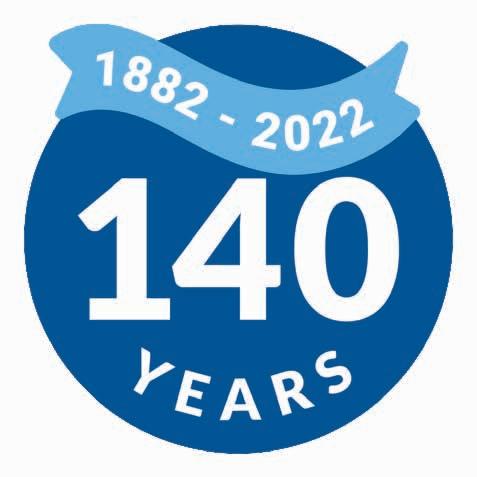

Although much has changed in how water is managed and supplied to meet the needs of our customers, we continue to innovate, invest and supply high quality water for our Island to thrive today and every day. of service to the Island



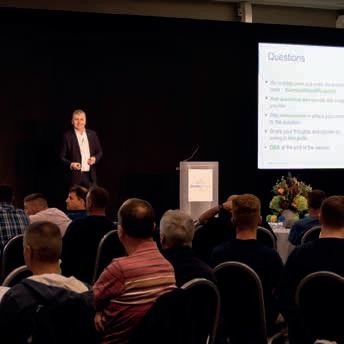



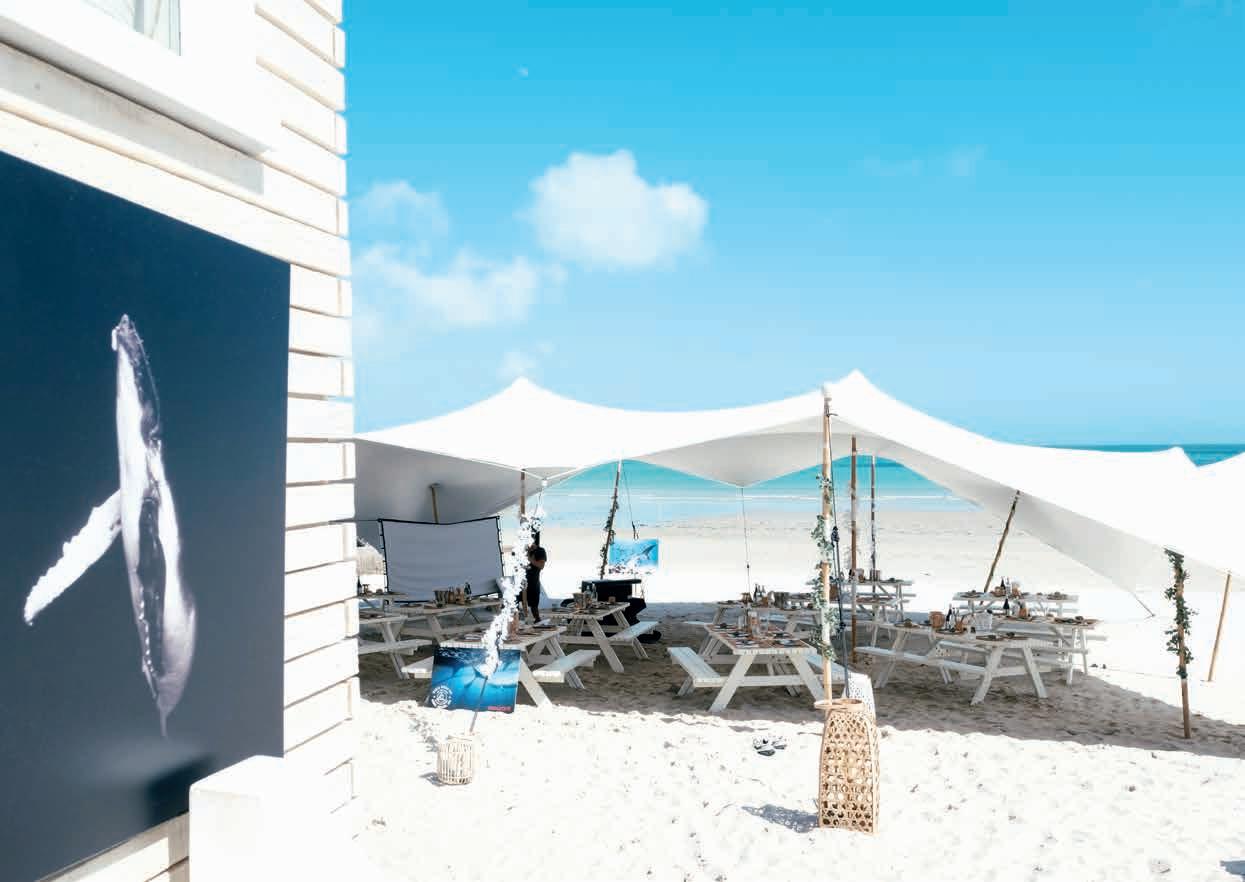
To celebrate World Ocean Day on 8 June we collaborated with Ocean Culture Life and the Government of Jersey IHE Blue Fish Campaign Team.
To deliver a series of educational workshops, both virtually and in person. Hundreds of primary school and home-schooled children in years 5 and 6 enjoyed either a beachside or virtual learning workshop. The workshops provided an overview of the local ocean ecosystem and the water cycle from sky to tap, along with interactive activities such as making your own water filter and performing water quality tests. Each child received a World Ocean Day workbook and a medal for their participation.


We challenged the children to get their sample of dirty pond water as clear as possible (or, to use the technical term, to achieve the lowest possible turbidity). They were given a set of materials (with some red herrings) and were asked to filter the water through a large bottle. Our Water Quality Team were on hand to test the water and judge whose was the clearest.

At Jersey Water, we believe all water is precious and a lot of hard work goes on behind the scenes to make sure it’s safe to drink. World Ocean Day is the ideal opportunity to engage our community and to help raise awareness that the ocean and its ecosystem are critical to the health and survival of all life.
We are delighted to be working in partnership with Ocean Culture Life and the Government of Jersey’s Blue Fish Campaign as part of World Oceans Day events to raise awareness of just how precious water is and why we must all protect it. At Jersey Water, our purpose is supplying the water for our Island to thrive today and every day and in order to do this, we all need to work together. Children are our future generation so the earlier we can get them forming good habits, the better.
Zöe Hibbs, Marketing and Communications Manager at Jersey WaterI just wanted to say thank you for this morning. The boys all enjoyed taking part in the World Ocean Day. They also loved doing the filtering activity afterwards. Thank you for the resources and information.
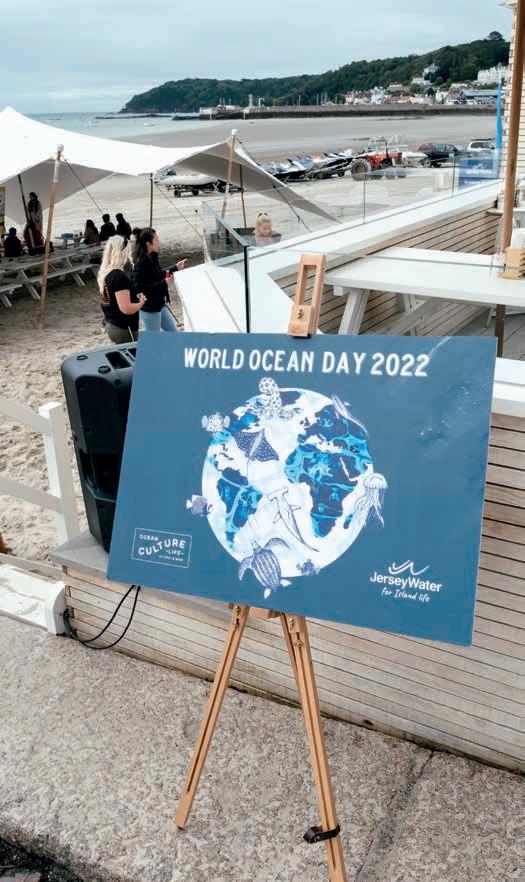
Year 6 Teacher, De la Salle Primary School

World Ocean Day is a way to celebrate our world’s ocean and our personal connection to the sea. Alongside Jersey Water, we have designed a beachside workshop aimed to motivate, inform and inspire children by offering a fun, interactive way to raise awareness about the crucial role the ocean plays in our lives, and the important ways people can help protect it.

We all feel something when in, on or around water. Being able to make the link between our Island’s water source and the ocean is crucial to ensure the future health of our ocean.


Tamsin Raine, Co-Founder of Ocean Culture Life

Thank you for the great live lesson yesterday. My class were fully engaged with it and the quiz aspect really kept them focused, they all love a bit of competition.
Year 4 teacher, Grands Vaux School


During 2022, we began to develop our sustainability strategy. Its goal is to align our actions so that we can reduce our carbon footprint and protect the environment, support the Government of Jersey’s Carbon Neutral Roadmap and align with the national Water UK Carbon Neutral Strategy.
We began measuring Jersey Water’s carbon footprint, starting with the years ended 30 September 2021 and 2022. These will be used as a baseline against which future reductions will be measured. We began training our employees on sustainable business practices. We also commenced a series of workshops with our Board, our leadership team and employees from across the business to assess current sustainability activity within Jersey Water, to develop ideas for further action, and to inform our strategy.
This strategy, due to be published in 2023, will set out our road map and timeline for taking Jersey Water to net zero. This will include the development of targets intended to reduce our emissions in line with the globally agreed, science-based targets designed to keep global warming below 1.5°C. It will also detail strategies for offsetting any residual emissions that cannot be eliminated. In addition to our journey to net zero, our strategy will also include our commitments to Jersey’s countryside and wildlife, the community we serve and the people with whom we work.
Our land around the reservoirs and the wider network of water catchment stations provides a valuable platform to deliver improvements to habitats supporting biodiversity across the Island. Our strategy will seek to tailor our reservoir and site management to maximise their positive ecological impact while maintaining safe, efficient operation and public access. We will
continue to work with our partners to support Jersey’s flora and fauna through the promotion of wildlife corridors, native hedgerow, and treeplanting schemes. One such scheme is the Green Grid Project, a collaboration between Jersey Water, Jersey Electricity, JT and the National Trust for Jersey. The three companies have joined together to support the National Trust for Jersey’s campaign to plant and restore the Island’s hedgerows. Teams from Jersey Electricity, JT and Jersey Water will volunteer their time to create the largest continuous grid of hedge corridors in Jersey, by planting and maintaining an additional five miles around the Island. This new five-mile area of hedge planting will take place in the north of the Island in and around St John, commencing at the beginning of December.
The ‘Green Grid’ partnership will enhance the existing grid of 26.5 miles of hedgerows which will help Jersey’s wildlife, landscape and natural resources to flourish.

Sustainability goes to the very heart of the essential service we provide to our community. As such, the water we supply will take centre stage in our sustainability strategy. We will work to ensure that the capture, treatment and production of water is as sustainable as possible in terms of carbon footprint. We will also seek to address the impacts that climate change, population growth and other local and macro factors are having on our Island’s water supply to ensure that it remains sustainable. Key elements will include reducing the demand for water through leakage reduction and increased water efficiency, and ensuring that we have sufficient water resources to meet future demand. We will also continue to work closely with key land users through the Action for Cleaner Water Group to ensure land management practices –particularly in the agricultural sector – are sustainable and working to reduce the risk of water pollution.
Our first calculations of Jersey Water’s carbon footprint show overall emissions of 344.28 tonnes in 2022 (2021: 328.66). Just over half of these emissions relate directly to the electrical energy costs involved in capturing, treating and distributing water to our customers, with the balance split between space heating and transport emissions.
Measurements are currently restricted to scope 1 and 2 emissions, as defined below. We intend to extend into the calculation of Scope 3 emissions on a case-by-case basis, as and when the information becomes available.

In line with the Greenhouse Gas Protocol, the methodologies we used to calculate the carbon intensity figures/emissions factors generated by Jersey Water are those published each year by DEFRA. In the case of emissions from electricity usage in Jersey, we use the emissions factors provided by Jersey Electricity for 2021.

Jersey Water’s strategic outcomes are subject to a number of risks and uncertainties that could, either individually or in combination, affect our operations, performance and future prospects. We identify and manage these and other risks through our risk appetite framework, whereby the amount and type of risk that we are willing to take on in order to meet our strategic outcomes is articulated through qualitative statements and tolerance levels.
Our underlying appetite for risk will vary according to the nature of the business activity and be driven by the need to manage, avoid or mitigate the risk, balanced by the cost of doing so, over the long term. Overall, we have a low appetite for risks that threaten the Company’s ability to fulfil its statutory responsibilities as the provider of potable mains water to the Island of Jersey, or that are likely to erode its trustworthiness and reputation among customers and the community.

The risks we identify are either:
Principal Risks, being risks we are actively managing now that could stop us achieving our strategic objectives; or



Emerging Risks, being risks that could be new, uncertain or changing risks not considered ‘current.’ Emerging risks may, at a time in the future, impact our operations, performance, and future prospects. They are identified through strategic planning and risk management processes, which include horizon scanning and scenario analysis. Emerging risks identified may affect the assessment of longer term horizon principal risks such as water supply risk and critical infrastructure risk where long term planning is an essential risk management activity, or they can shape our strategy through the challenge the uncertainty of the emerging risk creates. Pages 31-33 identify key challenges that we are trying to address through delivery of our strategic outcomes.
As part of the risk framework, we also consider the connectivity of principal risks. This information is used to further risk management activity and to inform the viability scenarios as detailed on page 59.
The following pages identify the principal risks and uncertainties included within the Company’s strategic risk register. Unknown risks and those that the directors believe are less significant may also have a material impact on the operations and performance of the Company.
The assessment and management of climate related risks and uncertainties is consistent with the approach used to manage risk through the business. The process for identifying and managing the impact of climate change on our principal risks is integrated within our strategic planning, resilience, and risk management processes. Climate change has significant influence on several principal risks associated with delivering ‘High Quality Water Supply’, ‘Environment and Community Benefit’ and the ability to be ‘Sustainable and Resilient', in particular, the risks of ‘Water Supply Failure, Political, Income and Profitability, and Environmental and Community Impact. The table detailing risk management activities for each principal risk includes initiatives that
incorporate climate change considerations (examples include the Water Resource and Drought Management Plan, investment in an electric vehicle fleet, and renewable energy consideration in all capital projects).
Whilst we have an extensive portfolio of environmentally positive initiatives, at present they are not embodied within an overarching sustainability strategy and there are currently no outcome objectives defined for our environmental improvements. The progress made on developing our sustainability strategy can be found on pages 28-29, which includes our carbon footprint base line. The strategy will include the development of science based targets for delivery between now and 2030.
Failing to comply with our legal requirement to maintain a supply of potable water sufficient to meet the reasonable needs of our customers. This could have adverse public health impacts and affect the financial performance and reputation of the Company.
Our Water Resource and Drought Management Plan indicates that, under worst historical drought conditions, there is a forecast deficit in water available for use against projected demand of 8.2Ml/day by 2045. The predictions are dependent on assumptions regarding population growth, changing demand for water and the effects of climate change on water available for use. There is the risk that, if no action is taken, we may be unable to meet the demand for water.
Short term events including drought, extremes of weather, pollution, changes in water quality, flooding and terrorism coupled with limited water storage capacity could result in insufficient water resources, increasing the risk of interruptions to supply or supply restrictions with a potentially adverse financial and reputational impact on the Company.
Risk Management Activities
• Water Resource and Drought Management Plan
• Drought response planning
• Spare treatment works capacity
• Universal customer metering
• Standby desalination capacity of 50% of daily demand
Over reliance on individuals with critical skills, knowledge or experience and the failure to plan adequately for their succession could disrupt the activities of the Company upon their departure, adversely affecting the quality of service provided and preventing business objectives from being achieved.
Access to individuals with the requisite skills and experience to deliver the technical roles within the water supply team is limited and often reliant on overseas recruitment. The rising cost of property and living in Jersey reduces the attractiveness of the Island as a place to work, increasing the risk that vacancies will remain unfilled. High
Unauthorised access to the Company’s systems potentially resulting in disruption to the business and/or a significant data breach.
Risk Management Activities
• Controlled access to Company systems
• Multiple layer physical and cyber security in place
competition for these skills in both the UK and on Island drives up salary inflation.
Risk Management Activities
• Achievement of Investors in People Silver standard
• Training and employee development commitment
• Performance development and leadership frameworks
• A competitive remuneration and benefits package
• Additional key technical resources recruited
• Raw water testing and monitoring
• Operational flexibility of raw water network
• Water efficiency strategy
• Working with key stakeholders on Drought Action Group
• Active leakage detection and repair
• Pressure management of treated water network
Movement in risk
Decreasing. There is the further need to mitigate the adverse impact on raw water quality from the introduction of greater volumes of desalinated water into Val de la Mare Reservoir. Indications are that the proposed extension of the desalination plant will need to incorporate re-mineralisation treatment to address low mineral content of desalinated water.
• Internal security audit of data and systems
• Technology supply chain risk assessment
• Supplier security assessments carried out prior to procurement stage
• Third party scrutiny of security arrangements
• New system implementations secure by design
Events outside of the Company’s control, including Brexit impact on borders and increasing complexity in customs clearance, conflict in the Ukraine, adverse weather, workforce availability and corporate failure could result in disruption to our supply chain.
The lack of access to critical stocks or the inability to procure services from key contractors could adversely impact the ability to maintain the
supply of water with consequential reputational, legal and financial implications.
Risk Management Activities
• Participation in the South Staffordshire Water purchasing consortium
• Large stocks of consumables and chemicals maintained on Island
• Mutual aid agreement with Guernsey Water and participation in UK water industry mutual
• Active benchmarking of roles and remuneration
• Implementation of a new Target Operating Model for the Water Supply team in progress Movement in risk
Decreasing. Mitigating activities are reducing the risk despite the continuing shortage of technical skills on Island and cost of living.
• Employee awareness and training
• Regular testing and enhancement of security arrangements Movement in risk
No change as new challenges offset improvements.
aid scheme
• Close working relationships with key contractors
• Active risk management Movement in risk
No change as new challenges offset improvements.
Exposure to rising costs, significant one-off costs or prolonged decrease in revenue may reduce profitability, affect financial performance and generate pressure to increase charges for water.
Risk Management Activities
• Financial governance model sets financial targets and objectives including keeping our tariff increases to a minimum
• Frequent and regular monitoring of financial performance
• Investment in systems and resources to enable development of long term asset investment strategy
• Comprehensive insurance cover in place
• Water Supply Target Operating Model
Non-compliance with drinking water quality standards potentially resulting in public health impacts, a loss of public confidence in the water supply and legal and reputational issues for the Company.
Risk Management Activities
• Robust water quality monitoring programme
• Drinking water safety plan approach to identify and address water quality risks in a systematic manner (currently being updated)
• Partnership approach to address Island wide water quality issues through the Action for Cleaner Water Group and PFAS Technical Officer Working Group
• 24/7 automated online quality monitoring for key parameters
• Automated control of key treatment processes
• In-house laboratory
• 24-hour manned treatment works
Failure to have a positive impact on the environment and community as a result of non - compliance or not meeting the expectations of our stakeholders.
Jersey has declared a climate emergency and the intention to be carbon neutral by 2050 reducing emissions in line with the Paris Agreement.
There is a growing body of best practice around sustainability and related disclosure.
Failure of a critical asset causing interruptions to supply with potentially adverse financial and reputational consequences.
May be impacted by carbon-zero strategy and/or climate events e.g. flooding, land erosion.
Risk Management Activities
• Redundancy capability designed into critical assets
Legislation or regulation may be introduced that has a material effect on the activities of the Company by introducing additional cost or placing additional compliance requirements.
Risk Management Activities
• Compliance with all applicable environmental laws and regulations
• Reliance on largely decarbonised electricity supply to power most plants and equipment
• Investment in an electric vehicle fleet
• Inclusion of renewable energy consideration in all capital projects
Increase in risk due to a combination of high inflation impacting operating and capital expenditure (particularly in relation to skills, chemicals, energy, and construction), compliance, and connectivity to movements in other principal risks where there is the potential requirement of significant expenditure to mitigate the risk.
• Desalination plant
• Two treatment works with some redundancy
• Online monitoring and alarm system using SCADA telemetry connecting sites
• Standardisation of treatment processes and equipment across sites
• 24-hour manned treatment works
• Stock of critical spares
• Ultraviolet treatment processes at both treatment works
• Ability to select and blend from several raw water reservoirs
• Temporary dispensations for Oxadixyl and Nitrates
Movement in risk
A decrease in risk.
Risk Management Activities
• Self-governance model adopted
• Best practice methodologies in place
• Continuous improvement culture
• Planned development of Jersey Water’s own sustainability strategy
• No-Mow-May campaign
• Refill Jersey Campaign
• Biodiversity action plans Movement in risk
No change reflecting current readiness for carbon -zero strategy and ahead of a formal sustainability strategy.
• Robust asset management system in development
• Cost benefit of further resilience measures being investigated
• Knowledge and experience of network among water supply team. Movement in risk No change.
• Close engagement with Government
• Active participation in public consultations on law or regulation change
Movement in risk No change.
Events including widespread illness, industrial action, civil unrest, and adverse weather could prevent a large number of employees from attending work, resulting in disruption to the operations including the ability to maintain normal standards of service.
Risk Management Activities
• Regular incident response exercises
Failure to maintain sufficient funds or facilities to finance the investment programme, service debt, cover the day-to-day operating cash-flow requirements and pay dividends. This, coupled with fluctuations in interest rates, may affect the cost of existing borrowing and the cost of securing any new borrowing.
• Flexible working practices and mobile technology enable rapid deployment to working from home
• Healthcare and wellbeing benefits including annual flu vaccination
• Active employee engagement and consultation
• Mutual-aid agreement with Guernsey Water and participation in UK water industry
mutual-aid scheme
• COVID-19 mitigation measures
• Annual heath checks through on island Occupational Health provider Movement in risk No change.
Risk Management Activities
• Low gearing capital structure, maintaining adequate cash headroom and credit facilities
• Hedging policy to regularly monitor and mitigate the impact of interest rate movements on credit facilities
• Interest rate swap to fix rates on £7.5m of debt
Failure to maintain the trust of our customers and deliver a great customer experience leading to lower satisfaction levels, along with, in the worst case, reputational and increasing regulatory consequences.
To successfully navigate water resource challenges, it is essential we maintain a good relationship with our customers so that we can
work together to reduce water consumption (and bills). Trustworthiness is essential in building that relationship.
Risk Management Activities
• Participation in the Institute of Customer Service annual benchmarking survey
• Communication and engagement strategy
• Virtual call centre to enable our team to deliver
• Effective processes for budgeting and stresstesting capital investment, operating expenditure and cash-flow requirements
• RCF includes accordion element to provide further funding as required.
Movement in risk No change.
resilient customer services
• Regular monitoring of local and social media
• Educational initiatives and open days
• Customer consultations
• Complaint monitoring and handling processes Movement in risk No change.
Events may occur that disrupt the delivery of significant change, operational and capital projects within the business, resulting in delays, additional costs and/or the ability to achieve the initial project objectives.
Failure to prevent injuries and accidents to our people and the public resulting in legal, financial and reputational issues.
Risk Management Activities
• Robust Health and Safety Framework
• Employee safety forum
Fluctuations in the value of the defined benefit scheme assets and liabilities (driven by movements in market indices) will result in volatility in the net funding position within the balance sheet, charges within the income statement and the cash contributions required from the Company.
Risk Management Activities
• Project governance for change programmes
• Independent/external scrutiny of programme
• Skilled project management professionals supporting delivery of key strategic projects
• Regular independent review
• Interaction with water industry health and safety forums
• Mobile safety knowledge base accessible to all employees
• Regular and topical training and updates
• Risk logs, progress reports and remedial actions subject to review by leadership team and the Board Movement in risk No change.
Risk Management Activities
• Scheme closed to new members on 31 December 2003
• Regular review of the scheme funding by the Board
• Scheme funding strategy seeks to balance the
• Wellbeing and other safety initiatives
• Regular Senior Executive briefings, review of performance and completion of corrective actions Movement in risk No change.
investment growth opportunity with liability matching to reduce volatility
• Closure to future accrual from 1 January 2022 Movement in risk
Decrease in risk with closure to future accrual and updated investment strategy.

Turnover
2021 2022 Target 2022
£18,356k £18,792k £18,223k
Operating profit £7,446k £5,950k £2,371k
Profit for the reporting year £5,976k £5,903k £1,561k
Capital expenditure £3,051k £10,820k £5,653k
Profit for 2022 totalled £5,903k (2021: £5,976k), higher than expected but slightly lower than 2021.
The increase on target was driven by the combination of increased consumption through the summer months, a fair value gain on derivative financial instruments of £1,364k, and a net curtailment gain of £2,656k resulting from the closure of the pension scheme. The prior year operating profit of £7,446k includes profit on the sale of two properties. Removing the impact of these one-off transactions in both 2021 and 2022, then, like -for-like results show a slight increase on 2021 of £69k.

Profit before tax £6,691k £6,765k
Less: Profit on disposal of property £(4,015k) –
Fair value gain on derivative financial instrument
Net curtailment gain on defined benefit pension scheme

– (£1,364k)
Turnover for the year was £18,792k (2021: £18,356k). The increase was £569k more than target and an increase of 2.4% or £436k on last year. The increase in turnover on prior year was a result of the following factors:
– (£2,656k)
Underlying profit before tax £2,676k £2,745k
• Higher water revenue of £414k taking overall water revenue to £17,671k (2021: £17,257k). This increase is attributable to a combination of a 3.5% tariff increase (effective 1 January 2022), approximately 250 new customers added to the network, and higher than expected water consumption – particularly commercial consumption in the second half of the year, driven by the long, hot summer. Prior to the summer, water consumption was lower than in the previous year, particularly for household customers which is likely to be driven by a return to pre-pandemic consumption patterns e.g. less working from home. This trend reversed over July and August before decreasing with the introduction of the temporary use ban and Save Water campaign at the end of August.
• A 15% (£83k) increase in revenue relating to the installation of new water mains and connections.
The defined benefit scheme was closed to future accrual from 1 January 2022. This closure meant that the Company had greater certainty over its future liabilities and eliminated the requirement to accrue defined benefits for future service costs. As a result, the Company was able to recognise a one-off net curtailment benefit of £2,656k in the income statement.
Operating expenditure of £15,458k was higher than anticipated and the prior year of £14,938k. This increase was driven by the following key variances:
• Inflation impacting many areas of expenditure, in particular chemical, energy and contractor expenditure.
• The write-off of costs associated with redeveloping the Millbrook site following a revision of our property strategy due to the purchase of our new site at Rue des Pres.
• Costs associated with new office site and temporary accommodation following the move from Mulcaster House.
• Increased insurance premiums resulting from higher replacement cost of critical assets (construction cost inflation and revaluation of potential work required).
• Costs related to running the desalination plant (principally electricity) and the accompanying Save Water campaign from August onwards.
Operating profits totalled £5,950k compared to £7,446k in the prior year. The main reason for the variance is the sale of properties in 2021 which generated a profit on disposal of £4,015k and the net curtailment gain of £2,656k in 2022. Removing the impact of these exceptional items, underlying operating profit was £3,294k, £137k below 2021.
Net finance income was £1,196k compared to an expense of £374k in the prior year. This was driven by the fair value gains on the derivative financial instrument.
Profit before taxation for the year was £6,765k, which is £74k or 1.1% higher than in 2021. Profit in both years was affected by exceptional items: profit on disposal of fixed assets in 2021, and the gains on the financial instrument and the pension curtailment in 2022.
Income tax charged in the period has increased by £147k on the prior period to £862k, primarily due the difference in tax treatment of property disposals, the net gain on curtailment and the derivative financial instrument.
Earnings per share for 2022 was £0.61 for each ordinary share, a decrease of £0.01 on 30 September 2021. 73.91% of the ordinary share capital of the Company is owned by the States of Jersey (representing 83.33% of voting rights), with the remaining 26.09% held by approximately 165 private and institutional investors.
The total cash paid to the States of Jersey by Jersey Water during the year, including dividends, was £5,163k (2021: £4,778k).



Dividends declared and paid
2022 2021
£’000 £’000
Previous year - Final dividend 1,480 1,427
Current year - Interim dividend 700 700 £2,180 £2,127
Current year - Final dividend £1,589 £1,480
Our Board aims to deliver real growth in dividends over time, recognising that short term adjustments may be necessary to allow for variations in financial performance, investment requirements, liquidity and other factors.
In determining the level of dividend in any year, in accordance with the policy, our Board considers several other factors that influence the proposed dividend payment, which include but are not limited to:
• Operational and financial performance of the business
• The level of dividend cover
• Available financial resources and distributable reserves
• Future cash commitments and investment requirements to sustain delivery of our strategic outcomes
• Any relevant external issues that may impact overall resilience.
For 2022, we are recommending a final dividend on the Ordinary and ‘A’ Ordinary shares of 16.449 pence per share (2021: 15.321 pence). This brings the total paid and proposed dividend for the year to 30 September 2022 to 23.693 pence per share, compared with (2021: 22.565 pence).
In 2022, the total capital expenditure was £10,820k. The majority of this related to our property programme, with £7,689k being spent on the new site at Rue des Pres and a further £1,385k on our property strategy, including our Corporate Services office at Durell House and operational hub at Rue Grellier.
Aside from the property programme, we continued to focus on achieving best practice standards and resilience throughout our infrastructure. We spent £1,051k on reducing leakage and improving water quality throughout our network infrastructure, plus a further £695k on new and upgraded assets throughout the business.
At the year end, Jersey Water held assets with net book value of £85,249k (2021: £76,484k), with tangible assets making up 96% of the book value at £82,169k (2021: 98% £74,625k).
We have one revolving credit facility for £15,000k. The revolving credit facility gives us the ability to proactively manage our level of borrowing, offsetting cash balances to reduce interest charges when there are timing differences between investment requirements. We used a combination of the facility and surplus cash to fund the purchase of our new site at Rue des Pres. Our loans and borrowing at 30 September 2022 therefore increased by £7,000k to £15,000k (2021: £8,000k).
During the year, to hedge against interest rate exposure, we executed a £7,500k, 10 year interest rate swap. Under FRS 102, this derivative liability is stated at a fair value of £1,364k on the statement of financial position. This gain on the fair value has been recognised in the income statement, reflecting the substantial movement in interest rate forecasts since the execution date.
There was a net cash outflow of £599k in 2022. Cash generated from operating activities in the year was £5,891, £639k lower than 2021. Cash inflows were lower than in the previous financial year due to a combination of tax payments, timings on payables and an increase in stock held. The purchase of our new property in summer 2022 resulted in a net outflow on investing activities, with a total of £10,728k spent on purchasing fixed assets offset by £7k received on the sale of assets. This large property purchase meant an increase in our borrowing by £7,000k. Once offset against higher interest rate charges and the payment of dividends, the total funds generated from financing activities were £4,231k.
The defined benefit pension scheme formally closed to future accrual on 1 January 2022. This realised an actuarial gain of £7,877k as the expected future obligations of the Company became more certain. The value of the scheme at the end of the year was £5,235k, compared to £2,819k in the prior year, with the actuarial gain and market factors being key drivers in the movement in the valuation (as detailed in more detail in note 22 of the financial statements, page 79).
The deferred tax liability increased in the year by £390k to £7,976k. The movement is primarily due to the amount charged to the statement of other comprehensive income in relation to the increase in fair value of the pension asset.
Passmore Finance Director7 December 2022
Natalie
Back row, left to right:
Anthony Ferrar Helier Smith Julie Taylor Daragh McDermott Michael Pocock
Front row, left to right: Louisa McInnes Heather MacCallum Natalie Passmore

Heather MacCallum Chair BA (Hons), CA
Tenure on Board
Anthony


Daragh
Helier Smith
Chief Executive
Tenure on Board
Appointed October 2003, Chief Executive since April 2015
Natalie
Tenure on Board
Appointed November 2021, Operations Director
Deloitte LLP

Gaspé House 66-72 Esplanade
St Helier Jersey JE2 3QT
Registered Office
2nd Floor
Durell House 28 New Street
St Helier Jersey JE1 1JW
Bankers
HSBC Bank PLC
HSBC House Esplanade St Helier Jersey JE1 1HS
We have chosen to adopt the principles of good corporate governance and best practice set out in the UK Corporate Governance Code (the ’Code’), as updated in 2018. The Board is of the opinion that the Company has complied with the main principles of the Code throughout the year under review.
Our Board currently comprises seven directors, three of whom are Executive Directors and four of whom are NonExecutive Directors. The Board has a schedule of regular board meetings – normally between eight and nine per financial year, with any additional meetings convened as and when required – together with one to two formal strategy sessions. None of the Executive Directors hold any non-executive directorship positions. However, Natalie is a Trustee of Art House Jersey, a Jersey registered charity.
The Board is collectively responsible for the long term resilience and success of Jersey Water. To achieve this, the Board sets the overall operating strategy, approves detailed business plans, and
oversees the delivery of objectives by continually monitoring performance against those plans. The Board also establishes the culture, standards, and values of the Company while overseeing the management of risk and monitoring financial performance and reporting, ensuring that appropriate and effective succession planning and remuneration policies are in place.
The Chair is responsible for leadership of the Board and ensuring its effectiveness in all aspects of its role. The NonExecutive Directors constructively challenge and help develop strategic proposals, bringing strong, independent judgement, knowledge, and experience to the Board’s deliberations. The Board has Audit, Nomination, Risk and Remuneration Committees in place; the
Board Board appointed Sub-Committee
terms of reference of the Committees are available on request from the Company Secretary.
While the Board maintains oversight through regular meetings, the day-to-day strategic operations of the Company are delegated to the Executives. The Board is supplied with a sufficient level of regular, detailed, and timely management information to allow it to discharge its functions effectively.
The table below sets out the number of meetings (including Committee meetings) held and attended during the financial year.
Audit Remuneration Risk Nomination
Number of meetings in 2022 8 1 2 3 2 2
Anthony Ferrar 8 1 2 2/2 2 2
Heather MacCallum 8 1 - 3 2 2
Daragh McDermott 8 - 2 - 1 2
Natalie Passmore 8 1 - - - -
Michael Pocock 8 - 2 3 2 2
Helier Smith 8 1 - - - -
Julie Taylor 7 - - - - -
The Board considers all the Non-Executive Directors to be independent in character and judgement. In determining independence, the Board considers the specific circumstances of each director, inclusive of those directors who have served more than nine years on the Board. The Board has concluded that Anthony Ferrar, Daragh McDermott and Michael Pocock shall be deemed independent.
Heather MacCallum, as Chair of the Company, was considered independent on appointment and, in accordance with the Code, is not subject to the independence test thereafter
In order to ensure that the Board and its Committees continue to operate effectively, an external evaluation took place during the prior financial year, in September 2021, using an external Corporate Governance specialist with no direct connection with Jersey Water. The findings from the evaluation were compiled into an action plan which was implemented during the FY2022. The keys areas for Board development and implementation have included enhancements to the NED induction processes; training and development for NEDs; enhancement of certain board processes and increased frequency of board members connecting and meeting outside of the normal board timetable; and strengthening relationships between the Executive and Non-Executive members.

During this financial year, and building on the external evaluation feedback, each individual board member has undertaken a performance review. This was co-ordinated by the Chair, along with an assessment of the Board and its Committees, to ensure that they continue to operate effectively, measuring their performance against a set of predefined targets.
Following this internal assessment, the Board concluded that for the reporting year, it possesses the requisite mix of skills, experience and knowledge required to approach, develop and deliver the strategies, challenges, opportunities and principal risks facing Jersey Water. Board composition is reviewed at least twice a year, with recommendations put forward to the Board by the Nomination Committee.
The Board has a process in place for reviewing the other significant commitments of Non-Executive Directors and their impact on the ability of the Non-Executive Directors to discharge their duties to Jersey Water.

It is the opinion of the Board that all Non-Executive Directors can effectively discharge their duties to Jersey Water.
Except where a director is appointed to fill a casual vacancy, all directors are appointed by the shareholders at the Annual General Meeting (AGM). One third of the directors, or where the number of directors is not a multiple of three, the number nearest to one third, retire by rotation (based upon length of service) and, where eligible, seek re-election each year. No director may serve a term of longer than three years without seeking re-election. We have adopted a policy of requiring all Non-Executive Directors who have served on the Board for nine years or more to retire from the Board and seek re-election on an annual basis. Directors appointed to fill a casual vacancy must seek formal appointment by shareholders at the next AGM.
The long term sustainable success of our business is dependent on our engagement with, and the support we receive from, our key stakeholders. Building positive relationships with our stakeholders that share our purpose and values is important to us, while working towards shared goals assists us in delivering long term sustainable success. This is explained in more detail on pages 28 and 29 of the Strategic Review.
There are various forms of engagement with teams and individual employees ranging from informal one to ones with the NEDs to more formal group workshops or consultations on specific topics. Output from such processes is reported back to the Board as necessary.
We are in regular contact with the Company’s majority and controlling shareholder, the States of Jersey, with whom we meet at least twice a year. Details of contact and the views of the States of Jersey are cascaded to the Board. We use events such as the AGM to interact with and hear the views of all shareholders. Due notice of the AGM, stating the business of the meeting,
is circulated to all shareholders in advance of the meeting in accordance with Companies (Jersey) Law, 1991, as amended. We monitor and review the votes received and consider the need to further engage with shareholders in the event of significant opposing votes.
The Board is responsible for ensuring that there are effective systems of internal control in place to reduce the risk of misstatement or loss and to ensure that we are operationally and financially resilient, with our strategic business objectives met. These systems are designed to manage and mitigate (rather than to eliminate) the risk of failure to achieve business objectives and can only provide reasonable and not absolute assurance against material misstatement or loss.
We have developed and adopted corporate and operational risk registers detailing and grading the significant risks we face. Alongside the register is a process through which the significant risks that the business faces are identified and evaluated on a regular basis and the controls operating over those risks are assessed by the Risk Committee to ensure their adequacy.
The process of financial risk assessment and reviewing the effectiveness of the systems of internal control is regularly reviewed by the Audit Committee in accordance with FRC’s ‘Guidance on Risk Management, Internal Control and Related Financial and Business Reporting’ and has been in place for the whole of the reporting period, up to and including the date on which the financial statements are approved.
Controls adopted by the Board (or its Committees) to ensure the effectiveness of the systems of internal control include:
• Review and approve the Risk Management Policy and Risk Appetite Statements;
• Review the corporate and operational risk and control registers maintained and updated by the Company and of the status of any actions arising from their regular review;
• Receive confirmation from senior management of the proper operation of controls throughout the reporting period;

• Review and approve the terms of reference of committees;
• Review and approve schedule of matters specifically reserved for its attention; and
• Review reports received from the Audit Committee concerning the findings of the external auditors on the financial statements of the Company and the systems of internal control.

The purpose and primary responsibility of the Committee is to support the Board with its responsibilities pertaining to financial reporting, in accordance with the Code and best practice.
I am pleased to report on the work of the Audit Committee for the financial year ended 30 September 2022.
The Committee, which I chair, comprises Daragh McDermott, Michael Pocock and myself. The external auditors, Executive Directors (Natalie Passmore, Julie Taylor and Helier Smith) and the Company Secretary, along with the Financial Controller, also attend the whole or parts of the meetings by invitation.
During the reporting period, the Committee met twice.
The composition of the Committee ensures that there are sufficient skills, experience, knowledge, professional qualifications, utility and water industry expertise to discharge the Committee’s responsibilities effectively. Biographical information of each of the members of the board can be found on the company website and for those members of the board standing for election or reelection their biographical information will be summarised in the 2023 annual general notice.
The terms of reference of the Audit Committee require it to meet at least twice per financial year. Additional meetings may be called when necessary. The Committee is charged by the Board to:
• Monitor the integrity of the financial statements of the Company and any formal announcements relating to the Company’s financial performance;
• Provide advice when requested by the Board, on whether the annual report
taken as a whole, is fair, balanced and understandable while providing the information necessary for shareholders to assess performance, the business model and strategy;
• Ensure that arrangements are in place for the proportionate and independent investigation of concerns raised confidentially by whistle-blowers about possible improprieties in matters of financial reporting or any other matters;
• Review and monitor the adequacy, operation and effectiveness of the Company’s risk-management and internal control systems, including internal financial controls, and make recommendations for improvement where necessary;
• Review and approve the statements to be included in the annual report concerning internal control and risk management, and the viability statement;
• Oversee the external audit process and manage the relationship with the external auditors;
• Compile a report on its activities to be included in the Company’s annual report;
• Exercise judgement in deciding which of the issues it considers in relation to the financial statements to be significant; and
• Make recommendations to the Board as to the re-election and remuneration of the auditors at the AGM (based upon its assessment of the performance of the auditors) giving due regard to their continued independence and any other regulatory or professional requirements.
The Committee regularly assesses the need for an internal audit function. Having taken into account current systems in place, including inspections and other third party assurance work, the Committee has determined that the establishment of such a function
in-house is, at the present time, given the size and complexity of Jersey Water, not cost effective. However, to enhance assurance practices, during 2023, a third party internal auditor will be engaged to carry out a review of customer revenue processes and internal controls. The internal audit function is considered by the Committee on at least an annual basis, where a balanced judgement is made.
Performance evaluation of the Audit Committee is described on page 43.
To enable the Committee to discharge its responsibilities effectively in respect of the financial statements, several processes are in place.
The Committee is briefed by Natalie Passmore in advance of the year end on the significant issues pertaining to the financial statements and how they will be dealt with. These issues are generally focused on the areas of subjectivity in the financial statements. For the 2022 year end, these include: defined benefit pension scheme valuation and closure to future accrual, the hedge accounting for the derivative financial instrument and the accounting for the property strategy changes. Further details can be found in notes 3 and 4 of the financial statements. The Committee also considered changes in accounting or disclosure requirements and the accounting or disclosure implications of one-off events occurring in the year. Where necessary, the Committee considers evidence and independent third party advice on the key matters for consideration.
At the end of the reporting year, the Committee reviews: the annual report, related announcements, going concern assumption and viability statement, and considers them in the context of the significant issues identified, the suitability of any key assumptions and the extent that they have been disclosed. The process is completed in
consultation with the auditors whose view is sought by the Committee. The Committee also considers, based on their knowledge of the business and issues arising, whether they can advise the Board that the annual report, as a whole, is fair, balanced and understandable, and provides the information necessary for shareholders to assess our position and performance, the business model and strategy.
Each period, the Committee considers the external auditors’ proposed approach and approves fees for the year end statutory audit. The performance and effectiveness of the external auditor is monitored continually and formally considered by the Audit Committee before a recommendation is made to the Board regarding their reappointment. Length of service of the incumbent audit firm, effectiveness of the audit process, the independence and
objectivity of the team, the depth and breadth of the audit approach, the level of fees and the quality of the service provided are all taken into account. Fees paid to the auditor for the statutory audit of the Company are detailed in note 6 of the financial statements.
The current auditor is Deloitte LLP with Kate Hadley as Lead Audit Partner. This reporting year will be Deloitte LLP’s sixth term as auditor.
During this reporting year, a competitive tender for the audit services for the year ended 30 September 2023 was initiated by the Audit Committee. The Committee concluded this process in July 2022 where it made the recommendation to the Board to appoint PKF BBA Ltd with David Moehle as Lead Audit Partner. This recommendation will be put forward to shareholders at the 2023 AGM.

The Audit Committee considers the impact of the provision of any non-audit services by the external auditor on the objectivity and independence of the audit. The consideration has regard to the nature of the non-audit work, size of the fee relative to audit fees, any potential involvement of the audit team in the work, and the longer term effect of any non-audit services on the relationship with the audit firm, including an assessment of their continuing objectivity and independence. The fees paid to the auditors for non-audit services are detailed in note 6 of the financial statements. Based on these procedures we are satisfied that the auditors are independent.
Anthony Ferrar Committee Chair 7 December2022
The Committee sets the remuneration policy for the Executive Directors and Senior Management, including remuneration packages and incentives such as annual performance related bonus payments. The Committee is also responsible for agreeing the rules of the performance related bonus scheme for the Executive Directors and Senior Leadership Team and approving the business objectives for the Executive Directors and Senior Leadership Team.
Non-Executive Director remuneration is determined by the Board of Directors.
I am pleased to report on the work of the Remuneration Committee for the financial year ended 30 September 2022.
The Committee, which I chair, comprises of Heather MacCallum, Anthony Ferrar and myself. The Executive Directors (Natalie Passmore, Julie Taylor and Helier Smith) and the Company Secretary may also attend the whole or parts of the meetings by invitation. Should external guidance or support be required, the Committee engages these services on an ad-hoc basis.
In the reporting period, the Remuneration Committee met three times. Additional meetings may be called when necessary – for example, when a specific matter arises requiring the Committee’s immediate attention.
The Remuneration Committee reviews Executive Director and Senior Leadership Team salaries, variable pay awards and remuneration packages annually, ensuring that they are appropriate, fair and competitive in light of relevant benchmarking data, incentivises improving performance and that Jersey Water can attract and retain employees in these key roles.
The Committee is charged by the Board to:
• Determine the policy on executive director and senior management remuneration and consider specific remuneration packages (including performance based incentives) for individual executive directors and senior management, having regard to the risk appetite of the Company and alignment with the Company’s long term strategic goals so that rewards are linked to improvements in overall performance (corporate and individual);
• Review and approve specific remuneration packages for all members of the Senior Leadership Team and the Executive Directors;
• Review the terms of executive directors and senior management’s service agreements from time to time;
• Provide oversight and scrutiny of the Executive’s pay-award decisions for those employees earning £60k or greater.
• Maintain contact as required with its principal shareholder regarding remuneration through the Chair of the Board; and
• At least once per year, or as required by the Board, the Committee will review its own performance, constitution and terms of reference to ensure it is operating at maximum effectiveness, and to recommend any changes it considers necessary to the Board for approval.
In executing its role, the Remuneration Committee considers external benchmarking data where appropriate.
Salary Bonus Awarded for 2022
Fee Benefits Total Remuneration (Excluding pension contributions) 2022 2021
£’000 £’000 £’000 £’000 £’000 £’000
Helier Smith 188 38 – 11 237 224
Natalie Passmore 128 22 – 9 159 150
Julie Taylor 117 22 – 13 152 –
Anthony Ferrar – – 25 – 25 24
Tim Herbert – – 8 – 8 21
Stephen Kay – – 8 – 8 21
Heather MacCallum – – 31 – 31 29
Daragh McDermott – – 23 – 23 21
Michael Pocock – – 23 – 23 21
During the year, the Company made pension contributions of £29k (2021: £28k) in respect of Helier Smith, £20k (2021: £19k) in respect of Natalie Passmore and £12k in respect of Julie Taylor. Benefits for Helier Smith, Natalie Passmore and Julie Taylor consist of private health care, death in service insurance, a car allowance and motor fuel benefit. Helier Smith and Natalie Passmore also receive prolonged disability insurance.
Julie Taylor was appointed as an Executive Director on 1 November 2021. Tim Herbert and Stephen Kay retired as Directors on 3 February 2022.
At the reporting date, we had total of 89 employees of which 64, or 72%, were male and 25, or 28%, were female. The table below shows the gender difference in the average hourly pay (mean and median). It is calculated as the difference between the average hourly pay of men and women as a proportion of average hourly pay of men as at the reporting date.
Pay gap 2022 2021
Mean -26% -21%
Median -34% -23%
The gender pay gap reflects the distribution and relative proportions of men and women across the Company. This does not consider any differences in the role that male and female employees perform, or their seniority.
The gender pay gap calculated shows that our female employees earn, on average, more than male employees in 2022 and 2021. This outcome arises from the proportion of total females in management and leadership positions in Jersey Water in comparison to male employees in similar positions as a proportion of the total male workforce (as detailed in the pie charts, above).
In addition to executing its normal duties during the year, the Committee began a review of Jersey Water’s remuneration strategy and policy for Executive Directors and Senior Management with a view to enhancing future remuneration related disclosure, maintaining compliance with best practice and reinforcing alignment between pay and rewards with long term business strategy.
2022 Amount 2022 Ratio 2021 Amount 2021 Ratio
At 25th percentile 31,563 5.96 30,900 5.83
At median 36,725 5.12 35,000 5.14
At 75th percentile 49,925 3.77 46,400 3.88
The Committee is pleased to include, for the first time in our annual report and financial statements, details of how the CEO remuneration compares to the rest of our employees. The table above reflects how the full-time equivalent annual salary of the CEO compares to employees at the 25th, 50th and 75th percentiles.
Employee pay awards are determined annually on a case by case basis and are influenced by several factors including the employee’s performance and contribution, market pay levels and
changes in the cost of living. The 2022 pay review also took account of the current cost of living crisis and focussed on protecting those at the lower end of the pay scale from the effects of the increased cost of living to a greater extent than those at the higher end.
December 2022
The purpose of the Committee is to support the Board with its responsibilities in relation to risk management and internal controls.
I am pleased to report on the work of the Risk Committee for the financial year ended 30 September 2022.
The Committee, which I chair, comprises of Heather MacCallum, Anthony Ferrar, Daragh McDermott and myself. The Executive Directors (Natalie Passmore, Julie Taylor and Helier Smith) and the Company Secretary may also attend the whole or parts of the meetings by invitation, together with senior members of the leadership team.
In the reporting period, the Risk Committee met twice. Additional meetings may be called when necessary.
The Committee is primarily responsible for reviewing Jersey Water’s internal controls and risk management processes, monitoring the principal and emerging risks, and monitoring the robustness of the Company’s risk management framework. The status of Jersey Water's risk profile is described on pages 31-33.
The Committee is charged by the Board to:
• Oversee the development, implementation and monitoring of the Company’s overall risk management framework and its risk strategy, principles and policies to ensure that they are robust, in line with emerging regulations, corporate governance and industry best practice, and are effective;
• Oversee the Company’s risk exposure and propose improvements to the Company’s risk management framework, strategy, principles and policies. This will include proposed changes to risk governance, risk appetite and risk policy frameworks, and the organisation’s risk universe;
• Review the adequacy of the Company’s risk management framework and the resources available to the Company to appropriately manage risk, conducting in-depth reviews of specific high-risk areas as required;
• Review and assess identified principal and emerging risks and determine how these may affect the achievement of the organisation’s strategic objectives and the continued resilience and viability of its business model;
• Review risk principles, policies and material amendments to such risk principles and policies, as recommended by the Executives, for approval by the Board;
• Oversee adherence to risk principles, policies and standards and any action taken resulting from material policy breaches;
• Review and approve the statements to be included in the annual report concerning internal control, risk management and the viability statement from a non-finance risk perspective;
• Report to the Board as to whether the organisation’s purpose, values and board approved risk culture expectations are appropriately embedded in the organisation’s risk strategy and risk appetite and are reflected in observed behaviours and decisions.
During the financial year, the Committee carried out an in-depth review of the Company's Water Resilience Framework, focusing on the scope and boundaries of the framework and the workflows needed, in the short, medium, and longer terms. Development of the framework will continue during the FY2023, with regular updates being provided to the Committee as the programme of works progresses. The Committee also conducted detailed reviews of the risk management policy and risk appetite statement, as well as of the corporate and operational risk registers, recommending that the intolerable risks are a standing agenda item at board level and reported on accordingly.
During the FY2022, an alternative water supply exercise was conducted. At the Committee’s June meeting, the learnings and conclusions of that exercise were presented to the Committee. The resulting action plan was endorsed by the Committee.
Pocock Committee Chair 7 December 2022
Michael
The key purposes of the Committee are to make recommendations to the Board in respect of Board and Committee composition, Board appointments and succession planning for senior leadership roles throughout Jersey Water.
I am pleased to report on the work of the Nomination Committee for the financial year ended 30 September 2022.
The Committee, which I chair, comprises of Anthony Ferrar, Daragh McDermott, Michael Pocock and myself. The Executive Directors (Natalie Passmore, Julie Taylor and Helier Smith) and the Company Secretary may also attend the whole or parts of the meetings by invitation.
In the reporting period, the Nomination Committee met twice.
The Committee is primarily responsible for the selection and appointment of the Company’s Executives and Non-Executive Directors as and when required.
The other duties of the Committee include to:
• Make recommendations to the Board as to the re-election of directors under the ‘retirement by rotation’ provisions in the Company’s Articles of Association, giving due regard to their performance and ability to continue to contribute to the Board in light of the knowledge, skills and experience required;
• Make recommendations to the Board for the re-appointment of any nonexecutive director at the conclusion of their specified term of office, giving due regard to their performance and ability to continue to contribute to the Board in the light of the knowledge, skills and experience required;
• Regularly review the structure, size and composition of the Board (including the balance of skills and attributes required of the Board compared to its current position) and make recommendations to the Board with regard to any changes;
• Keep under review the leadership needs of the organisation, both executive, non-executive and other senior executives, including succession plans, with a view to ensuring the continued ability of the organisation to operate effectively, and make recommendations to the Board thereon.
When selecting candidates for potential appointment as a non-executive director, the Committee evaluates the needs of the Company and identifies the necessary skills and experience required by candidates for consideration. As a matter of policy, the Chair of the Board is not permitted to chair the Committee when it is dealing with the matter of succession to the Chair. The Nomination Committee makes recommendations to the Board considering the performance of the candidates at interview, their skills and experience and their ability to meet the specific needs of the Company. Consideration is given to the use of external recruitment consultants and open advertising in the recruitment process. Terms and conditions of appointment of non-executive directors are available for inspection at the Company’s registered address during normal business hours and at the AGM.
It is the policy of the Board to appoint directors who have a diverse range of skills, attributes and backgrounds so that, collectively, the Board is appropriately resourced to discharge its duties effectively and meet the changing needs of the business. A wide range of factors are considered in determining the appropriate composition of the Board, including, but not limited to: technical expertise, local market knowledge and experience,
independence, length of service on the Board and diversity, including age and gender balance.
The Committee recognises the important contribution the Board makes to the long term sustainable success of Jersey Water. At least annually, the Committee formally considers the structure, size and composition required of the Board to meet the current and future needs of the Company. In accordance with our articles of association, at each AGM, one-third of the directors in office retire by rotation and seek re-election, with no director remaining in office for longer than three years since their last re/election. Biographical information of each of the members of the board can be found on the company website and for those members of the board standing for election or re-election their biographical information will be summarised in the 2023 annual general notice.
A rigorous recruitment process is in place for the appointment of nonexecutive directors to enable the Board to populate itself with directors who have a diverse range of skills and attributes.
During the financial year, the Committee considered the Board and Committee compositions, assessing the mix of skills, experience and knowledge required to approach, develop and deliver on the strategies, challenges, opportunities, and principal risks facing Jersey Water.
Heather MacCallum Committee Chair 7 December 2022

The Company, which was incorporated in 1882, has adopted ‘Jersey Water’ as its trading name. Jersey Water is the sole supplier of treated water to the Island of Jersey.
Both Handois Holdings Limited, a private Jersey holding company, and De La Haye Plant Limited, a water haulage company, are wholly owned by Jersey Water (the Company). Together all three companies form the Company.
Jersey Water paid an interim dividend of 7.244 pence per share on 13 June 2022 (2021: 7.244 pence). The Directors are proposing a final dividend on ordinary and ‘A’ ordinary shares for 2022 of 16.449 pence per share (2021: 15.321 pence).
2022 2021
The directors of Jersey Water on the date the consolidated financial statements were approved are detailed on page 40. Daragh McDermott will be retiring at the 2023 AGM and will not be seeking re-election and re-appointment.
£'000 £'000
Interim dividend paid 700 700 Final dividend proposed 1,589 1,480 £2,289 £2,180
In the 2022 reporting year, Jersey Water paid dividends on preference shares totalling £381k.
The process of identifying two new Non-Executive Directors (to fill the casual vacancies following both Tim Herbert (at the 2022 AGM) and Daragh’s retirements) is currently underway with the prospective Non-Executive Directors standing for appointment and election to the Board of Director at the 2023 AGM, on 22 March 2023.
As described on page 43, the Board undertook an annual formal assessment of its performance and that of the individual directors, including structured meetings between the directors being assessed and the Chair. Following this review, the Chair and Senior Independent Director have confirmed that the directors standing for re-election at the AGM continue to perform effectively and demonstrate commitment to their roles.
“Jersey Water is the sole supplier of treated water to the Island of Jersey.”


Particulars of the holdings of the directors, including family and beneficial interests, in the share capital of the Company as at 30 September 2022 are:
Heather MacCallum 24,100 5,223
Natalie Passmore 915 -
Helier Smith 925 589

Michael Pocock 650 -
The States of Jersey is the Company’s majority and controlling shareholder. Daragh McDermott is the Chief Executive Officer JT Global Limited which is wholly owned by the States of Jersey.
Jersey Water maintains an insurance policy on behalf of all directors and officers of the Company against liability arising from neglect, breach of duty and breach of trust in relation to their activities as directors and officers.
Set out below are details of the significant voting rights (3% or more) in shares of Jersey Water as at 7 December 2022:
Shareholder
% of total voting rights held The States of Jersey 83.33%
The States of Jersey owns 4,620,000 (100%) ‘A’ Ordinary shares, 2,520,000 (50%) Ordinary shares and 900,000 (100%) 10% cumulative fifth preference shares. The ‘A’ Ordinary shares, while in their ownership, have voting rights that confer twice the number of votes than those cast in respect of all other shares.
A resolution to elect and appoint PKF BBA Limited as the Company’s auditor will be proposed at the forthcoming AGM.
For and on behalf of the Board Louisa McInnes Company Secretary 7 December 2022
The directors are responsible for preparing the Annual Report and the financial statements in accordance with applicable law and regulations.
The Companies (Jersey) Law 1991 requires the directors to prepare financial statements for each financial year in accordance with generally accepted accounting principles. The financial statements of the Company are required by law to give a true and fair view of the state of affairs of the Company and of the profit or loss of the Company for that period. In preparing these financial statements, the directors should:
• Select suitable accounting policies and then apply them consistently;
• Make judgements and estimates that are reasonable and prudent;
• Specify which generally accepted accounting principles have been adopted in their preparation;
• Notify its Shareholders of the use of disclosure exemptions, if any, used in the preparation of the financial statements;
• Prepare the financial statements on the going concern basis of accounting unless it is inappropriate to presume that the Company will continue in business.

The directors are responsible for keeping accounting records which are sufficient to show and explain its transactions and to disclose with reasonable accuracy at any time the financial position of the Company. Therefore, enabling them to ensure that the financial statements prepared by the Company comply with the requirements of the Companies (Jersey) Law 1991. They are also responsible for safeguarding the assets of the Company and henceforth taking reasonable steps for the prevention and detection of fraud and other irregularities.
They are further responsible for the maintenance and integrity of the corporate and financial information included on the Company’s website. Legislation in Jersey governing the preparation and dissemination of financial statements may differ from legislation in other jurisdictions.
We confirm that, having considered all of the matters considered by the Board during the year and to the best of our knowledge, the financial statements, taken as a whole, are fair, balanced and understandable and provide the information necessary for shareholders to assess the Company’s position and performance, business model and strategy.
We confirm that we have carried out a review of the Company’s risk management and internal control systems. We are satisfied that the systems are aligned with our strategic objectives and these systems are being developed, applied and maintained appropriately. We are satisfied that the Company has effective processes in place to monitor and review material financial, operational and compliance controls.
The Directors are responsible for assessing and expressing their view on the longer term viability of the Company, taking into account the Company’s current position and principal risks. The Code requires that Directors should explain this process and outcome in the annual report.
In accordance with the Code, the Directors have assessed the prospect for the Company over a longer period than the 12 months required by the ‘Going Concern’ provision. The Board conducted this review for a period of five years, in line with the Company’s five-year strategic business plan, for which the Company has sufficiently robust financial forecasts. The fiveyear plan contains sufficiently robust financial forecasts, made up of detailed plans for the years one and two with indicative forecasts for years three to five. Capital investment plans are detailed for the full five years.
The Board has considered the impact that the principal risks or combination of risks may have on the business, including those that would threaten its business model, future performance, solvency, or liquidity. A summary of the principal risks can be found on pages 31-33. Where relevant, financial forecasts were subject to sensitivity analysis to illustrate the potential effects of significant risks, and to identify whether any could represent serious threats to the Company’s liquidity or operation.
The following sensitivities were used in stress-testing the forecasts:
• Climate events resulting in the need to restrict water use;
• An operational failure or pollution event impacting our ability to produce water, thus requiring increased expenditure from the operation of the desalination plant for a significant period of time;
• Increased operating and financing costs as a result of increasing inflation and higher interest rates;


• Persistently low profitability resulting from higher than anticipated costs;
• The operational and financial impact of significant supplychain disruption; and
• Significant cyber event.
The stress testing included (but was not limited to) various combinations of the following risk mitigation:
• Operating the desalination plant for a significant period;
• Replacement of critical infrastructure;
• Alternative water treatment processes;
• Re-prioritisation of investment;
• Tariff change; and
• The insurance we have in place for a material, adverse event.

Scenario outcomes were also considered, along with the Company’s financial resources, the ability to raise finance, the Water Resource and Drought Management Plan, its wide and varied customer base within Jersey, the steady demand for its products and services and its stable and well established treatment and distribution network.
Based on the assessment of prospects and viability described, we confirm that we have a reasonable expectation that the Company will be able to continue in operation and meet its liabilities as they fall due over the five-year period ending 30 September 2027.
We also consider it appropriate to prepare the financial statements on a ‘going concern’ basis, as explained in note 3 (‘Basis of preparation’) of the financial statements.
Approved by the Board on 7 December 2022 and signed on its behalf by Heather MacCallum Chair
In our opinion the financial statements of The Jersey New Waterworks Company Limited and its subsidiaries (the ‘Company’):
• give a true and fair view of the state of the Company’s affairs as at 30 September 2022 and of the Company’s profit for the year then ended;
• have been properly prepared in accordance with United Kingdom Generally Accepted Accounting Practice, including [Financial Reporting Standard 102 “The Financial Reporting Standard applicable in the UK and Republic of Ireland”; and
• have been properly prepared in accordance with the Companies (Jersey) Law 1991.
We have audited the financial statements which comprise:
• the consolidated income statement;
• the consolidated statement of comprehensive income;
• the consolidated statement of financial position;
• the consolidated statement of changes in equity;
• the consolidated statement of cash flows; and
• the related notes 1 to 28.
The financial reporting framework that has been applied in their preparation is applicable law and United Kingdom Accounting Standards, including Financial Reporting Standard 102 “The Financial Reporting Standard applicable in the UK and Republic of Ireland” (United Kingdom Generally Accepted Accounting Practice).
We conducted our audit in accordance with International Standards on Auditing (ISAs) and applicable law. Our responsibilities under those standards are further described in the auditor's responsibilities for the audit of the financial statements section of our report.
We are independent of the Company in accordance with International Ethics Standards Board for Accountants’ Code of Ethics for Professional Accountants (IESBA Code) together with the ethical requirements that are relevant to our audit of the financial statements in the UK, and we have fulfilled our other ethical responsibilities in accordance with these requirements. We believe that the audit evidence we have obtained is sufficient and appropriate to provide a basis for our opinion.
The other information comprises the information included in the annual report, other than the financial statements and our auditor’s report thereon. The directors are responsible for the other information contained within the annual report. Our opinion on the financial statements does not cover the other information and we do not express any form of assurance conclusion thereon.
Our responsibility is to read the other information and, in doing so, consider whether the other information is materially inconsistent with the financial statements or our knowledge obtained in the course of the audit, or otherwise appears to be materially misstated. If we identify such material inconsistencies or apparent material misstatements, we are required to determine whether this gives rise to a material misstatement in the financial statements themselves. If, based on the work we have performed, we conclude that there is a material misstatement of this other information, we are required to report that fact.
We have nothing to report in this regard.
As explained more fully in the statement of directors’ responsibilities, the directors are responsible for the preparation of the financial statements and for being satisfied that they give a true and fair view, and for such internal control as the directors determine is necessary to enable the preparation of financial statements that are free from material misstatement, whether due to fraud or error.
In preparing the financial statements, the directors are responsible for assessing the Company’s ability to continue as a going concern, disclosing, as applicable, matters related to going concern and using the going concern basis of accounting unless the directors either intend to liquidate the Company or to cease operations, or have no realistic alternative but to do so.
Our objectives are to obtain reasonable assurance about whether the financial statements as a whole are free from material misstatement, whether due to fraud or error, and to issue an auditor's report that includes our opinion. Reasonable assurance is a high level of assurance, but is not a guarantee that an audit conducted in accordance with ISAs will always detect a material misstatement when it exists. Misstatements
can arise from fraud or error and are considered material if, individually or in the aggregate, they could reasonably be expected to influence the economic decisions of users taken on the basis of these financial statements.
As part of an audit in accordance with ISAs, we exercise professional judgment and maintain professional scepticism throughout the audit. We also:
• Identify and assess the risks of material misstatement of the financial statements, whether due to fraud or error, design and perform audit procedures responsive to those risks, and obtain audit evidence that is sufficient and appropriate to provide a basis for our opinion. The risk of not detecting a material misstatement resulting from fraud is higher than for one resulting from error, as fraud may involve collusion, forgery, intentional omissions, misrepresentations, or the override of internal control.
• Obtain an understanding of internal control relevant to the audit in order to design audit procedures that are appropriate in the circumstances, but not for the purpose of expressing an opinion on the effectiveness of the Company’s internal control.
• Evaluate the appropriateness of accounting policies used and the reasonableness of accounting estimates and related disclosures made by directors.
• Conclude on the appropriateness of management’s use of the going concern basis of accounting and, based on the audit evidence obtained, whether a material uncertainty exists related to events or conditions that may cast significant doubt on the Company’s ability to continue as a going concern. If we conclude that a material uncertainty exists, we are required to draw attention in our auditor’s report to the related disclosures in the financial statements or, if audit evidence obtained up to the date of our auditor’s report. However, future events or conditions may cause the Company to cease to continue as a going concern.
• Evaluate the overall presentation, structure and content of the financial statements, including the disclosures, and whether the financial statements represent the underlying transactions and events in a manner that achieves fair presentation.
• Obtain sufficient appropriate audit evidence regarding the financial information of the entities or business activities within the Company to express an opinion on the consolidated financial statements. We are responsible for the direction, supervision and performance of the Company audit. We remain solely responsible for our audit opinion.
We communicate with those charged with governance regarding, among other matters, the planned scope and timing of the audit and significant audit findings, including any significant deficiencies in internal control that we identify during our audit.
Under the Companies (Jersey) Law 1991 we are required to report in respect of the following matters if, in our opinion:
• proper accounting records have not been kept by the parent company, or proper returns adequate for our audit have not been received from branches not visited by us; or
• the financial statements are not in agreement with the accounting records and returns; or
• we have not received all the information and explanations we require for our audit.
We have nothing to report in respect of these matters.
This report is made solely to the company’s members, as a body, in accordance with Article 113A of the Companies (Jersey) Law 1991. Our audit work has been undertaken so that we might state to the company’s members those matters we are required to state to them in an auditor’s report and for no other purpose. To the fullest extent permitted by law, we do not accept or assume responsibility to anyone other than the company and the company’s members as a body, for our audit work, for this report, or for the opinions we have formed.
For and on behalf of Deloitte LLP Birmingham, United Kingdom 8 December 2022
Consolidated Income Statement
For the year ended 30 September 2022
Note 2022 2021
£'000 £'000 £'000 £'000 Turnover 5 18,792 18,356
Net gain on curtailment of defined benefit pension scheme 22 2,656 –(Loss)/gain on disposal of fixed assets (40) 4,028 Operating expenditure 6 (15,458) (14,938) Operating profit 5,950 7,446
- interest receivable and similar income 8a 57 8
- interest payable and similar expenses 8b (225) (382) - fair value gains on derivative financial instrument 8c & 19 1,364 -
Net finance income/(expediture) 1,196 (374)
Non-equity dividends 9 (381) (381) 815 (755)
Profit before taxation 6,765 6,691 Income tax 10a (862) (715) Profit for the reporting year £5,903 £5,976
Basic and diluted earnings per ordinary share of £0.50 11 £0.61 £0.62
The results for the current and prior years all relate to continuing operations.
For the year ended 30 September 2022
Note 2022 2021 £'000 £'000
Profit for the reporting year 5,903 5,976
Fair value movement on derivative financial instrument - 101 Re-measurements of defined benefit obligations 22 (235) 2,650
Total income tax on components of other comprehensive income 10b (484) (547)
Other comprehensive (loss)/income for the year net of tax £(719) £2,204 Total comprehensive income for the year £5,184 £8,180
Note 2022 2021 £'000 £'000 £'000 £'000
Fixed assets Intangible assets 13 1,697 1,790 Tangible assets 14 82,169 74,625 Goodwill 13 19 69 Derivative financial instrument 19 1,364 –85,249 76,484
Current assets
Inventories 15 700 501 Trade receivables 16 4,609 4,714 Cash and cash equivalents 1,821 2,420 7,130 7,635
Creditors – Amounts falling due within one year Creditors and accruals 17 (2,355) (2,464) Income tax (1,250) (859) (3,605) (3,323)
Net current assets 3,525 4,312 Total assets less current liabilities 88,774 80,796
Creditors – Amounts falling due after more than one year
Borrowings 18 (15,000) (8,000) Non-equity preference shares 20b (5,382) (5,382) (20,382) (13,382)
Provisions for liabilities and charges
Deferred taxation 21 (7,976) (7,586) Net assets excluding pension asset 60,416 59,828 Pension asset 22 5,235 2,819
Net assets £65,651 £62,647
Capital and reserves
Called up equity share capital 20a 4,830 4,830 Reserves 60,821 57,817
Total equity £65,651 £62,647
The financial statements on pages 62 to 82 were approved by the Board of Directors on 7 December 2022 and were signed on its behalf by:
Note Called-up equity share capital
Retained earnings Total £'000 £'000 £'000 £'000 £'000
Revaluation reserve Cash flow hedge reserve
Balance as at 1 October 2020 4,830 675 (85) 51,174 56,594
Profit for the reporting year – – – 5,976 5,976 Other comprehensive income for the year – – 85 2,119 2,204
Total comprehensive income for the year – – 85 8,095 8,180 Equity dividends 12 – – – (2,127) (2,127)
Balance as at 30 September 2021 £4,830 £675 £– £57,142 £62,647
Balance as at 1 October 2021 4,830 675 – 57,142 62,647
Profit for the reporting year – – – 5,903 5,903 Other comprehensive income for the year – – – (719) (719)
Total comprehensive income for the year – – – 5,184 5,184 Equity dividends 12 – – – (2,180) (2,180)
Balance as at 30 September 2022 £4,830 £675 £– £60,146 £65,651
For the year ended 30 September 2022
Note 2022 2021 £'000 £'000
Net cash inflow from operating activities 23 6,456 6,846
Income tax paid (565) (316)
Net cash generated from operating activities 5,891 6,530
Cash flow (used in)/generated from investing activities
Purchase of fixed assets (10,728) (3,590) Disposal of fixed assets 7 5,035
Net cash (used in)/generated from investing activities (10,721) 1,445
Cash flow from/(used in) financing activities
Loans received 18 48,000 15,000
Loans repaid 18 (41,000) (21,900)
Interest paid and similar expenses (208) (423)
Non-equity dividends paid (381) (381) Equity dividends paid (2,180) (2,127)
Net cash from/(used in) financing activities 4,231 (9,831)
Net decrease in cash and cash equivalents 24 (599) (1,856)
Cash and cash equivalents at the beginning of the year 2,420 4,277 Effect of foreign exchange rate changes – (1)
Cash and cash equivalents at the end of the year £1,821 £2,420
The results for the current and prior years all relate to continuing operations
Reconciliation of net cash flow to movement in debt
Note 2022 2021 £'000 £'000
Decrease in cash and cash equivalents 24 (599) (1,856)
Net movement in borrowings 24 (7,000) 6,900
Movement in derivative financial instrument 24 1,364 108 Effect of foreign exchange rate changes 24 – (1)
Movement in net debt 24 (6,235) 5,151
Net debt as at 1 October 24 (10,962) (16,113)
Net debt as at 30 September 24 £(17,197) £(10,962)
The Jersey New Waterworks Company Limited (the Company) supplies potable mains water to the Island of Jersey. Its 100% owned subsidiary, Handois Holdings Limited, is a holding company which in turn owns 100% of the issued share capital of De La Haye Plant Limited. De La Haye Plant Limited supplies tankered water, swimming-pool filling and refilling and building site bulk water supply services.
The Company is a public company limited by shares and is incorporated and domiciled in Jersey. The address of its registered office is Second Floor, Durell House, 28 New Street, St Helier, Jersey, JE1 1JW.
The financial statements of the Company have been prepared in compliance with United Kingdom Accounting Standards, including Financial Reporting Standard 102, The Financial Reporting Standard applicable in the United Kingdom and the Republic of Ireland (‘FRS 102’) and Companies (Jersey) Law 1991.
The principal accounting policies applied in the preparation of these financial statements are set out below. These policies have been consistently applied to all periods presented, unless otherwise stated.
The financial statements are prepared on a going concern basis, under the historical cost convention, as modified for non-basic financial instruments measured at fair value through profit or loss. Amendments to accounting standards effective for the year ended 30 September 2022 had no material impact on the financial statements of the Company.
The preparation of financial statements in conformity with FRS 102 requires the use of certain critical accounting estimates. It also requires management to exercise its judgement in the process of applying the Company’s accounting policies. The areas and estimates involving a higher degree of judgement or complexity, or areas where assumptions and estimates are significant to the financial statements, are disclosed in note 4.
The Company’s business activities, together with the factors likely to affect its future development, performance and position, and a summary of the financial position of the Company, its cash flows and liquidity position, are described in the Strategic Report on pages 2-39, Financial Review on pages 34-39, and in notes 18 and 19. During the year the Company entered into an interest rate swap contract to hedge against the interest rate exposure on its revolving credit facility. This is described in the Financial Review on page 38 and in note 19. The Company has a wide and varied customer base within Jersey, steady demand for the supply of drinking water and services, and a stable and well established treatment and distribution network. The Company’s forecasts and projections take into account reasonable possible changes in trading performance. The combination of these measures and the financial analysis concluded that the Company expects to be able to operate within the level of their current facilities and available cash resources. As a consequence, the Directors believe that the Company is well placed to manage its business risks successfully despite the current uncertain economic outlook. The Directors have a reasonable expectation that the Company has adequate resources to continue in operational existence for a minimum 12 months after signing these consolidated financial statements. Accordingly, they continue to adopt the going concern basis in preparing the annual report and financial statements.
The Company’s consolidated financial statements include the financial statements of the Company and all of its subsidiary undertakings.
A subsidiary is an entity controlled by the Company. Control is the power to govern the financial and operating policies of an entity to obtain benefits from its activities.
The subsidiaries held by the Company have the same accounting policies as the Company and no adjustments are required to be made to those subsidiary financial statements to apply the Company’s accounting policies when preparing the consolidated financial statements.
Any subsidiary undertakings acquired are included from, or up to, the dates of change of control or change of significant influence. All intra-company transactions, balances, income and expenses are eliminated on consolidation.
Under Article 105 (11) of the Companies (Jersey) Law 1991, the directors of a holding company need not prepare separate company financial statements, if consolidated accounts for the company are prepared, unless required to do so by the members of the company by ordinary resolution. The members of the Company have not passed a resolution requiring separate accounts and, in the opinion of the Directors, the Company meets the definition of a holding company. As permitted by the law, the Directors have elected not to prepare separate financial statements for the Company.
The financial statements are presented in pound sterling and rounded to thousands.
The Company’s functional and presentation currency is the pound sterling.
The Company has a Euro bank account which holds a minimal working cash balance for the purposes of settling ad-hoc payments in Euros.
Foreign currency transactions are translated into the functional currency using the spot exchange rates at the dates of the transactions.
At each period end, foreign currency monetary items are translated using the closing rate.
Foreign exchange gains and losses resulting from the settlement of transactions and from the translation at period end exchange rates of monetary assets and liabilities denominated in foreign currencies are recognised in the income statement.
Turnover is measured at the fair value of the consideration received or receivable when services are delivered. Turnover represents the total value of water charges net of goods and services tax (GST), together with minor contracts, rental income and income from the delivery of tankered water. Income from minor contracts (rechargeable works income) is recognised within turnover upon completion of the contracted works. Income arising on minor contracts to be provided in the future is treated as deferred income.
Water charges are billed either as a fixed rate (in advance) or as a metered charge (in arrears). Both fixed rate and metered water income are recognised for the years ended 30 September 2022 and 30 September 2021. All water meters are read on a cyclical basis, approximately every 12 weeks. As a result, there will be an element of water charges which are accrued at the end of the financial period. All accrued water income is estimated based on historical consumption plus or minus a seasonal adjustment factor.
(ii)
Rechargeable works income relates to charges applied to offset costs of installing new service mains and services to properties across the Island.
In accordance with normal water industry practice, no value is placed on stocks of water held within reservoirs, treatment works or the mains network.
Inventory is valued at the lower of cost and estimated selling price, less costs to complete and sell, which is the equivalent to the net realisable value. Inventory relates to consumables used in the provision of services and is therefore recognised as an expense in the income statement in the period in which it is used. Inventory may also be allocated to capital projects undertaken during the year.
Cost is determined on a weighted average cost basis, which includes the purchase price, including taxes and duties and transport and handling directly attributable to bringing the inventory to its present location and condition.
At the end of each reporting period, inventory is assessed for impairment. If an item of inventory is impaired, the identified inventory is reduced to its selling price less costs to sell and an impairment charge is recognised in the income statement. Where a reversal of the impairment is recognised, the impairment charge is reversed, up to the original impairment loss, and is recognised as a credit in the income statement.
Business combinations are accounted for by applying the purchase method.
The cost of a business combination is the fair value of the consideration paid, liabilities incurred or assumed and of equity instruments issued, plus the costs directly attributable to the business combination.
On acquisition of a business, fair values are attributed to the identifiable assets and liabilities unless the fair value cannot be measured reliably, in which case the value is incorporated in goodwill.
Goodwill recognised represents the excess of the fair value and directly attributable costs of the purchase consideration over the fair values to the Company’s interest in the identifiable assets and liabilities acquired.
Goodwill is amortised over its expected useful life, estimated to be five years. Goodwill is assessed for impairment when there are indicators of impairment and any impairment is charged to the income statement. No reversals of impairment are recognised.
Computer software is stated at cost less accumulated amortisation and accumulated impairment losses. Software is amortised over its estimated useful economic life of between three to ten years on a straight-line basis.
The assets are reviewed for impairment if factors such as technological advancement or changes in market price indicate that residual value or useful life have changed. If there is impairment the residual value, useful economic life or amortisation rate are amended prospectively to reflect the new circumstances. Any impairment is charged to the income statement in the period in which it arises.
Intangible fixed assets under construction or development are recognised as Intangible Uncompleted Works until such time as they are ready for use. Expenditure on intangible assets under construction or development will only be recognised once it has met the development criteria under FRS 102. Upon completion, the asset is transferred to its appropriate asset category and amortisation commences. Subsequent qualifying expenditure is transferred directly to its appropriate asset category.
Tangible fixed assets are stated at cost less accumulated depreciation and accumulated impairment losses. Cost includes the original purchase price, costs directly attributable to bring the asset to its working condition for its intended use, dismantling and restoration costs.
Tangible fixed assets under construction are recognised within Tangible Uncompleted Works until such time as they are ready for use. At this point, the asset is transferred to Property and Completed Works and depreciation commences. If the major components of a tangible asset have significantly different patterns of consumption of economic benefits the Company will recognise those components as separately identifiable assets. Subsequent qualifying expenditure is transferred directly to Property and Completed Works.
Expenditure incurred on a tangible fixed asset, after the asset has been transferred to Property and Completed Works, will be recognised as part of the carrying amount of the asset if it is specifically related to a major inspection, overhaul or contractual performance test, provided it has met the asset-recognition criteria within FRS 102.
Depreciation is charged on a straight-line basis in accordance with the rates of depreciation set out below for each major asset type. No depreciation is provided on freehold land.
Asset type Depreciation period
Water mains - Ductile iron 80 years - Others 50 years
Buildings 30-100 years
Impounding reservoirs and dams 60-100 years
Dam-lining membranes 50 years
Pumping plant 10-40 years
Reinforced-concrete structures 100 years
Water meters 15 years
Motor vehicles 5-8 years
Mobile plant and tools 3-10 years
Reverse osmosis membranes 3-10 years
Office equipment and IT hardware 3-5 years IT software 3-10 years
Cash and cash equivalents includes cash in hand, at bank and held on deposit for fixed terms of up to three months. These items are included within Cash in the statement of financial position.
The Company has chosen to adopt sections 11 and 12 of FRS 102 in respect of financial instruments.
Basic financial assets, including trade and other receivables, cash and bank balances and investments are initially recorded at transaction price, unless the arrangement constitutes a financing transaction where the transaction is measured at the present value of the future receipts discounted at a market rate of interest. Such assets are subsequently carried at amortised cost using the effective interest method.
At the end of each reporting period, financial assets measured at amortised cost are assessed for objective evidence of impairment. If an asset is impaired, the impairment loss is the difference between the carrying amount and the present value of the estimated cash flows discounted at the asset’s original effective interest rate. The impairment loss is recognised in the income statement or statement of comprehensive income.
Where an impairment loss subsequently reverses, the carrying value of the asset is increased such that the amount does not exceed what the carrying amount would have been had the impairment not previously been recognised. The impairment reversal is recognised in the income statement or statement of comprehensive income.
Financial assets are derecognised when a) the contractual rights to the cash flows from the asset expire or are settled, or b) substantially all the risks and rewards of the ownership of the assets are transferred to another party, or c) despite having retained some significant risks and rewards of ownership, control of the asset has been transferred to another party who has the practical ability to unilaterally sell the asset to an unrelated third party without imposing additional restrictions.
Basic financial liabilities, including trade and other payables, bank loans and preference shares that are classified as debt, are initially recognised at transaction price (including transaction costs), unless the arrangement constitutes a financing transaction, where the debt instrument is measured at the present value of the future receipts discounted at a market rate of interest. Debt instruments are subsequently carried at amortised cost, using the effective interest rate method.
Financial liabilities are derecognised when the liability is extinguished, that is, when the contractual obligation is discharged, cancelled or expires.
Preference shares, which result in fixed returns to the holder, are classified as liabilities. The dividends on these preference shares are recognised in the income statement as non-equity dividends.
Derivatives such as interest rate swaps are not basic financial instruments.
Derivatives are initially recognised at fair value on the date a derivative contract is entered into and are subsequently remeasured at their fair value. Changes in the fair value of derivatives are recognised in the income statement as finance costs or finance income as appropriate, unless they are included in a hedging arrangement.
The Company can choose to apply hedge accounting for transactions entered into to manage the cash flow exposures of borrowings. In line with the Company’s hedging policy, interest rate swaps may be held to manage the interest rate exposures and are designated as cash flow hedges of variable-rate borrowings.
Changes in the fair values of derivatives designated as cash flow hedges, and which are effective, are recognised in other comprehensive income. Any ineffectiveness in the hedging relationship (being the excess of the cumulative change in fair value of the hedged item since inception of the hedge) is recognised in the income statement.
The gain or loss recognised in other comprehensive income is reclassified to the income statement when interest is incurred and when the hedge relationship ends. Hedge accounting is discontinued when the hedging instrument expires, no longer meets the hedging criteria, the forecast transaction is no longer highly probable, the hedge instrument is derecognised, or the hedging instrument is terminated.
Taxation expense for the period comprises current and deferred tax recognised in the reporting period. Tax is recognised in the income statement, except to the extent that it relates to items recognised in other comprehensive income or directly in equity. In this case, tax is also recognised in other comprehensive income or directly in equity respectively. Tax is calculated on the basis of tax rates and laws that have been enacted or substantively enacted by the period end.
Current or deferred taxation assets and liabilities are not discounted.
Current tax is the amount of income tax payable in respect of the taxable profit for the year or prior years.
Deferred tax arises from timing differences that are the difference between taxable profits and total comprehensive income as stated in the financial statements. These timing differences arise from the inclusion of income and expenses in tax assessments in periods different from those in which they are recognised in the financial statements.
Deferred tax is recognised on all timing differences at the reporting date. Unrelieved tax losses and other deferred tax assets are only recognised when it is probable that they will be recovered against the reversal of deferred tax liabilities or other future taxable profits.
The Company provides a range of benefits to employees, including paid holiday arrangements and defined benefit and defined contribution pension plans.
Short-term benefits, including holiday pay and other similar non-monetary benefits, are recognised as an expense in the period in which the service is received.
(ii) Defined
The Company operates a defined contribution scheme for its employees. A defined contribution scheme is a pension plan under which the Company pays contributions into a separate entity. The contributions are recognised as an expense in the period they are due. Amounts not paid are shown in accruals in the statement of financial position. The assets of the plan are held separately from the Company in independently administered funds.
(iii) Defined
The Company operates a defined benefit scheme for certain employees. A defined benefit scheme defines the pension benefit that the employee will receive on retirement, usually depending upon several factors, including age, length of service and remuneration. A defined benefit scheme is a pension plan that is not a defined contribution scheme. The scheme closed to future accrual with effect from 1 January 2022.
The asset or liability recognised in the statement of financial position in respect of the defined benefit scheme is the present value of the defined benefit obligation at the end of the reporting date less the fair value of the scheme assets at the reporting date.
The defined benefit obligation is calculated using the projected unit credit method. The Company engages independent actuaries to calculate the annual year end obligation. The present value is determined by discounting the estimated future payments using market yields on high quality corporate bonds that are denominated in sterling and that have terms approximating the estimated period of the future payments (discount rate).
The fair value of scheme assets is measured in accordance with the FRS 102 fair value hierarchy and in accordance with the Company’s policy for similarly held assets. This includes the use of appropriate valuation techniques.
Actuarial gains and losses arising from experience adjustments and changes in actuarial assumptions are charged or credited to other comprehensive income. These amounts, together with the return on scheme assets, less amounts included in net interest, are disclosed as re-measurement of net defined benefit liability/asset.
The cost of the defined benefit scheme is recognised in the income statement as employee costs, except where included in the cost of an asset, and comprises:
(a) The increase in pension benefit liability arising from employee service during the period; and (b) The cost of scheme benefit changes, curtailments and settlements.
The net interest cost is calculated by applying the discount rate to the net balance of the defined benefit obligation and the fair value of scheme assets. The cost is recognised in the income statement within net interest expense.
Following the closure of the scheme to future accrual during the year, the Company has recognised a net curtailment benefit separately on the face of the income statement.
Ordinary and ‘A’ ordinary shares are classified as equity. Incremental costs directly attributable to the issue of any new ordinary or ‘A’ ordinary shares would be shown in equity as a deduction, net of tax, from the proceeds.
Equity dividends to the Company’s shareholders are recognised as a liability in the financial statements in the period in which the dividends and other distributions are approved by the shareholders. These amounts are recognised in the statement of changes in equity.
The Company is applying the exemption available under FRS 102 section 33.11, which exempts the Company from reporting related party transactions, balances and commitments with a state that controls it, and with other entities that are related parties because the same state has control over them.
Estimates and judgements are continually evaluated and are based on historical experience and other factors, including expectation of future events, that are believed to be reasonable under the circumstances.
In the process of applying the Company’s accounting policies, the critical judgements applied by the Company in the current reporting period are detailed below.
Due to the nature of certain projects, including timing delays, specific contractual obligations or payment schedules, and the nature of the assets in question, the Company must occasionally apply judgement in deciding the point at which the asset was deemed ready for use. See notes 3, 13 and 14 for further details on tangible and intangible assets.
The Company has contractual rights to the Core systems implemented during the financial year for a period of five years, with the option to extend for a further five years. Based on historical experience, the Company has judged that it would expect to use the Core systems for the full ten year period and that costs associated with creating these intangible assets are therefore to be depreciated on a straight-line basis over a period of ten years.
The Company makes estimates and assumptions concerning the future. The resulting accounting estimates will, by definition, seldom equal the related actual results. The estimates and assumptions that have a significant risk of causing a material adjustment to the carrying amounts of assets and liabilities within the next reporting period are addressed below.
The Company has an obligation to pay pension benefits to certain employees. The cost of these benefits and the present value of the obligation depends on a number of factors, including life expectancy, asset valuations and the discount rate on corporate bonds. Management obtains estimates of these factors in determining the net pension obligation in the statement of financial position. The assumptions reflect historical experience and current trends. See note 22 for disclosures relating to the defined benefit pension scheme and estimates used.
The Company invoices its customers daily, on a cyclical basis. On average, customers will receive a bill covering a 90 day period. The Company makes an estimate of income due on unbilled water consumption at the reporting date based on historical average consumption. Following the disruption caused by the COVID-19 pandemic, the Company has seen its billing and consumption patterns return to within normal ranges. As a result, and when combined with the historical forecasting accuracy, the Company feels that there is no longer uncertainty around this estimation and will be removing this note in future years. See note 16 for the carrying amount of accrued income.
2022 2021 £'000 £'000
Measured water charges 16,588 16,277
Unmeasured water charges 349 342 Service charges and other charges for water 734 638
Total water supply charges 17,671 17,257
Rechargeable works income 628 545 Other income 493 554
Turnover £18,792 £18,356
Included in operating expenditure are the following:
Note 2022 2021 £'000 £'000
Net employment costs 7 5,035 5,210
(Reversal of impairment)/impairment of inventory 15 (162) 15
Write off of tangible uncompleted works 14 316 –
Amortisation and depreciation 13/14 3,056 2,966
Inventories recognised as an expense 867 771
Consumables, hired in services and other costs 6,086 5,718
Directors’ fees 118 137
Auditors' fees
- Statutory audit 120 88
- Other services (Tax compliance) 10 19
- Other services (Pension scheme audit) 12 13
Foreign exchange loss – 1
Total operating expenditure £15,458 £14,938
Included within consumables, hired in services and other costs are non-cancellable lease payments amounting to £140k (2021: £17k). The total future minimum lease payments under non-cancellable operating leases for each of the following periods are:
2022 2021 £'000 £'000
Not later than one year 194 104
Later than one and not later than five years 529 417
Later than five years 296 400
Total future minimum lease payments £1,019 £921
2022 2021 £'000 £'000
Wages, salaries and other payments 4,386 4,570
Social security 256 259
Pension costs of defined benefit scheme 76 380
Pension costs of defined contribution scheme 380 234 5,098 5,443
Less amount capitalised within fixed assets (63) (233)
Net employment costs £5,035 £5,210
Included within wages, salaries and other payments are Directors emoluments for the financial year which amounts to £539k (2021: £374k). The Remuneration Committee report on page 48 provides further details on salaries and benefits.
a) Interest receivable and similar income
2022 2021 £'000 £'000
Net interest income on pension obligations £57 £8
b) Interest payable and similar expenses
2022 2021 £'000 £'000
Bank loans, revolving credit facility and overdrafts 178 184
Refinancing costs 31 121
Interest on derivative financial instrument 16 77
Total interest payable and similar expenses £225 £382
c) Other finance income
Note 2022 2021 £'000 £'000
Fair value gains on derivative financial instrument 19 £1,364 £–
2022 2021
Paid Payable Charge for the year Paid Payable Charge for the year £'000 £'000 £'000 £'000 £'000 £'000
5% cumulative preference shares 3 1 3 3 1 3 3.5% cumulative second preference shares 3 – 3 3 – 3 3% cumulative third preference shares 3 1 3 3 1 3 3.75% cumulative third preference shares 3 1 3 3 1 3 5% cumulative third preference shares 2 1 2 2 1 2 2% cumulative fourth preference shares 7 2 7 7 2 7 10% cumulative fifth preference shares 360 90 360 360 90 360
Total dividends on non-equity shares recognised in the year £381 £96 £381 £381 £96 £381
a) Tax expense included in the income statement
2022 2021 £'000 £'000
Current tax Income tax on the profit for the year 955 611 Deferred tax (Credit)/charge for the year (93) 104
Total tax on profit £862 £715
b) Tax expense included in other comprehensive income
2022 2021 £'000 £'000
Current tax Movement relating to pension surplus 1 59 Deferred tax Movement on deferred tax relating to derivative financial instrument – 16 Movement on deferred tax relating to pension surplus 483 472
Total tax charge included in other comprehensive income £484 £547
The tax assessed for the year is lower than the standard rate of Jersey income tax (20%) (2021: 20%) applicable to utility companies. The differences are explained below:
2022 2021 £'000 £'000
Consolidated profit before tax 6,765 6,691
Profit before tax multiplied by the standard rate of Jersey income tax of 20% 1,353 1,339
Tax at 20% on:
Depreciation for the year in excess of capital allowances 121 250
Capital expenditure, deductible for tax purposes (163) (155)
Loss/(gain) on disposal of fixed assets 8 (805)
Dividends on non-equity shares – non-deductible 76 76
Net gain on curtailment of defined benefit scheme (531) –Non-deductible expenses 9 3
Adjustment for prior year tax charge (11) 7
Total tax charge for year £862 £715
Basic and diluted earnings per ordinary share of £0.61 (2021: £0.62) is based on earnings of £5,903k (2021: £5,976k), being the profit available for distribution to equity shareholders and 9,660,000 (2021: 9,660,000) ordinary and 'A' ordinary shares of £0.50 in issue.
Ordinary and ‘A’ Ordinary shares 2022 2021 2022 2021
Pence per share Pence per share £'000 £'000
Dividends paid
Final dividend for the previous year 15.321 14.771 1,480 1,427 Interim dividend for the current year 7.244 7.244 700 700 22.565 22.015 £2,180 £2,127
Dividends proposed Final dividend for the current year 16.449 15.321 £1,589 £1,480
The proposed final dividend is subject to approval by shareholders at the AGM and has not been included as a liability in the financial statements.
Cost
Goodwill Software Intangible uncompleted works
Total
£'000 £'000 £'000 £'000
As at 1 October 2021 252 2,702 22 2,976 Additions – 63 118 181 Disposals – (15) – (15) Transfers – 6 (6) –As at 30 September 2022 £252 £2,756 £134 £3,142
As at 1 October 2021 (183) (934) – (1,117) Charge for the year (50) (274) – (324) Disposals – 15 – 15 As at 30 September 2022 £(233) £(1,193) £– £(1,426)
Net book value
As at 1 October 2021 £69 £1,768 £22 £1,859 As at 30 September 2022 £19 £1,563 £134 £1,716
The above amortisation charges are included within operating expenses in the consolidated income statement. Included within intangible fixed assets is £2k (2021: £129k) relating to internal labour costs capitalised in the year.
At 30 September 2022, capital commitments contracted for amounted to £59k (2021: £100k).
Cost
Property and completed works Tangible uncompleted works
Total £'000 £'000 £'000 £'000
Motor vehicles, mobile plant and equipment
As at 1 October 2021 116,015 959 3,134 120,108 Additions 8,965 1,561 113 10,639 Disposals (125) (316) (147) (588) Transfers 931 (1,134) 203 –As at 30 September 2022 £125,786 £1,070 £3,303 £130,159
As at 1 October 2021 (43,209) – (2,274) (45,483) Charge for the year (2,415) – (317) (2,732) Disposals 87 – 138 225 As at 30 September 2022 £(45,537) £– £(2,453) £(47,990)
Net book value
As at 1 October 2021 £72,806 £959 £860 £74,625
As at 30 September 2022 £80,249 £1,070 £850 £82,169
The above depreciation charges are included within operating expenses in the consolidated income statement.
Additions to property and completed works include the purchase of two buildings at Rue Sinnatt for a combined £7,689k. As a result of these purchases, the Company decided not to proceed with further redevelopment of the Millbrook site and costs of £316k were written off from tangible uncompleted works. These costs are included within disposals in the above table.
Included within intangible and tangible fixed assets is £61k (2021: £104k) relating to internal labour costs capitalised in the year.
At 30 September 2022, capital commitments contracted for amounted to £659k (2021: £253k).
2022 2021 £'000 £'000
Inventory as at 1 October 823 807 Inventory purchased in year 904 787 Inventory consumed in year (867) (771) Inventory as at 30 September 860 823
Provision for impairment as at 1 October (322) (307) Movement in provision in year 162 (15) Provision for impairment as at 30 September (160) (322)
Net inventory balance as at 30 September £700 £501
Inventory includes desalination plant spares, pipes and fittings, chemicals, meters, fuel and other materials which will be consumed in the course of daily operations.
2022 2021 £'000 £'000
Trade debtors 2,051 2,017 Prepayments 580 700
Accrued income 1,954 1,970 Other debtors 24 27 £4,609 £4,714
Accrued income relates solely to unbilled measured water. The movement in the balances for accrued income and trade debtors is related to cyclical and quarterly billing timing differences, and variability in the seasonal adjustment.
The fair value of trade and other receivables is considered by the Directors to be equivalent to its carrying value because of their short-term nature.
2022 2021 £'000 £'000
Trade payables 77 234 GST, taxation and social security 180 362 Other creditors 808 698 Contract retentions 20 –Accruals and deferred income 1,270 1,170 £2,355 £2,464
Trade payables and accruals relate to amounts owed to various suppliers through the normal course of business. There was £94k deferred income as at 30 September 2022 (2021: £92k).
The fair value of creditors and accruals is considered by the Directors to be equivalent to their carrying value because of their short term nature.
Repayment
2022 2021 Dates £'000 £'000
Facilities drawn down HSBC Bank plc 2025 £15,000 £8,000
Loans falling due after two years but within five years £15,000 £8,000
The Company has a rolling overdraft facility with HSBC Bank plc.
On 4 June 2021, the Company entered into an unsecured £15,000k revolving credit facility (RCF) with HSBC Bank plc. The termination date of the RCF was 4 June 2024 with the option to extend for two consecutive years. During the year, the Company exercised the option to extend the termination date for a period of one year to 4 June 2025. Each utilisation of the RCF is shown as a repayment of the existing principal and a new borrowing within the statement of cash flows. As such the increase in the RCF of £7,000k from 2021, is shown as a gross outflow of £41,000k and a gross inflow of £48,000k.
The accrued interest payable on loans drawn down as at 30 September 2022 is £22k (2021: £4k). The accrued interest on the undrawn portion of the facility is £nil (2021: £1k).
The borrowings have been taken out to refinance existing borrowing and fund capital expenditure.
The Company has the following financial instruments:
2022 2021 £'000 £'000
Financial assets that are debt instruments measured at amortised cost 2,054 2,396 Financial assets at fair value through profit or loss 1,364 –Financial liabilities that are measured at amortised cost 22,610 15,467
Derivative financial instruments
The Company actively reviews its interest rate exposure risk in accordance with its interest rate hedging policy. The Company policy includes trigger levels requiring the Company to formally consider whether a hedge is required. These include:
• 3 year interest rate swap exceeds 1.25%;
• consecutive months of 3 year swap rate increases; and
• total drawdowns of above £15,000k and interest rate swap levels rising.
The trigger points were met during the year and the Company entered into an interest rate swap contract with HSBC Bank plc with an effective date of 3 May 2022 to hedge against the interest rate exposure of the Company on the revolving credit facility. The interest rate swap contract has a nominal value of £7,500k and matures on 4 May 2032. The fair value used by the Company to value the swap is calculated as the net present value of future cash flows (present value of future cash flows estimated and discounted based on the applicable yield curves derived from quoted interest rates present value of future cash flows estimated and discounted based on the applicable yield curves derived from quoted interest rates) expected to be paid or received under the swap contract.
The following table details the notional principal amounts and remaining terms of interest rate swap contracts outstanding as at the reporting date:
years
The interest rate swap settles on a quarterly basis. The Company settles or receives the difference between the fixed and floating interest rate on a net basis.
The interest rate swap contract exchanges floating rate interest amounts for fixed rate interest amounts and is designated as a cash flow hedge to reduce the Company’s cash flow exposure resulting from variable interest rates on borrowings. The hedged cash flows are expected to occur and to affect the consolidated income statement of the period to maturity of the interest rate swap.
The Company valued the derivative on 30 September 2022 as an asset of £1,364k, generating a fair value movement of £1,364k. As the Company has not elected to apply hedge accounting for this instrument the gain has been recognised within net finance income.
a) Called up equity share capital
Authorised, issued and fully paid up
Shares of 0.50 each 2022 2021 '000 £'000 £'000
Ordinary shares 5,040 2,520 2,520 ‘A’ Ordinary shares 4,620 2,310 2,310 9,660 £4,830 £4,830
Ordinary and ‘A’ ordinary shares carry no right to fixed income and rank after preference shares and other liabilities. Each ordinary share carries one vote in the event of a poll. Each ‘A’ ordinary share, while in the ownership of the States of Jersey, entitles the holder to such additional votes at a poll as brings the total number of votes attaching to the ‘A’ ordinary shares to twice the number of votes cast in respect of all other shares.
2022 2021 £'000 £'000
Authorised 20,000 cumulative preference shares of £5 100 100 20,000 cumulative second preference shares of £5 100 100 100,000 cumulative third preference shares of £5 500 500 100,645 cumulative fourth preference shares of £5 503 503 900,000 cumulative fifth preference shares of £5 4,500 4,500 £5,703 £5,703
2022 2021 £'000 £'000
Issued and fully paid 17,261 5% cumulative preference shares of £5 86 86 17,402 3.5% cumulative second preference shares of £5 87 87 23,509 3% cumulative third preference shares of £5 118 118 16,036 3.75% cumulative third preference shares of £5 80 80 11,400 5% cumulative third preference shares of £5 57 57 90,877 2% cumulative fourth preference shares of £5 454 454 900,000 10% cumulative fifth preference shares of £5 4,500 4,500 £5,382 £5,382
Preference shares bear interest at the rates indicated above and rank, in the order listed, above ordinary and ‘A’ ordinary equity shares in the event of winding up.
Upon a poll, every holder of a preference share present at a general meeting in person or by proxy shall have one vote only for all the preference shares held by the holder, irrespective of the number and class of such preference shares.
Note 2022 2021 £'000 £'000
Accelerated capital allowances 6,929 7,022
Asset arising from pension surplus 1,047 564
Net liability £7,976 £7,586
As at 1 October 7,586 6,994
Amounts charged in the income statement 10a (93) 104
Amounts charged in comprehensive income 10b 483 488
At 30 September £7,976 £7,586
There are no unrecognised deferred tax assets. There is no expiry date on timing differences, unused tax losses or tax credits.
During the year, the Company operated two formal pension schemes: a defined contribution scheme and a defined benefit scheme. There are also certain past employees whose pension or pension supplements, which are of a defined benefit nature, have not been funded by the Company’s present or previous pension agreements (the unfunded scheme). Where applicable, the liability of the Company in respect of the unfunded scheme is included within the disclosure below relating to the defined benefit section. The defined benefit section of the scheme was closed to new entrants with effect from 1 January 2003 and closed to future accrual with effect from 1 January 2022.
The defined benefit scheme is a section of The Jersey Water Pension Plan (the Plan). The Plan is administered by trustees responsible for ensuring that the Plan is sufficiently funded to meet current and future obligations. Prior to closure of the scheme to future accrual, the Company had agreed a funding plan with the trustees which was in place until 1 January 2022, whereby ordinary contributions were made into the scheme based on a percentage of active employees’ salary. Additional funding is agreed with the trustees to reduce any funding deficit where necessary.
The defined contribution scheme was opened to new members on 1 May 2003. It was a section of the Plan until March 2016, when it was transferred under a Master Trust arrangement to the Blue Riband Channel Islands Retirement Plan, established and administered by BWCI Pension Trustees Limited.
Defined contribution section
Employer contributions during the year ended 30 September 2022 totalled £380k (2021: £234k). There are no unpaid contributions at year end (2021: £nil).
Defined benefit section and unfunded scheme
The FRS 102 valuation as at 30 September 2022 shows a net asset of £5,235k (2021: £2,819k).
The major assumptions used by the independent actuary were:
2022 2021
Rate of increase in salaries (no longer applicable following cessation of accrual) – 3.72%
Rate of increase in pensions accrued after 1 January 1999 3.49% 3.45%
Discount rate 5.35% 2.00%
Inflation assumption 3.79% 3.72%
Life expectancy assumptions
Current pensioners at 65 - Male 87 87
Current pensioners at 65 - Female 89 89
Future pensioners at 65 - Male 89 89 Future pensioners at 65 - Female 91 90
The post-retirement mortality assumptions allow for expected changes in longevity. The overall expected rate of return is based on the weighted average return of each class of asset at the start of each accounting period.
Assets Liabilities Total £'000 £'000 £'000
Reconciliation of the present value of scheme assets and liabilities
At 1 October 2021 31,051 (28,232) 2,819
Benefits paid (4,471) 4,471 –
Employer contributions 16 – 16
Current service cost – (76) (76)
Past service cost – (318) (318)
Curtailments – 2,974 2,974
Employee contributions 12 (12) –
Interest income/(expense) 577 (520) 57
Life assurance premiums (2) – (2)
Re-measurement gains/(losses)
- Actuarial gains – 7,877 7,877 - Expense on plan assets excluding interest income (8,112) – (8,112)
As at 30 September 2022 £19,071 £(13,836) £5,235
Defined benefit section and unfunded scheme (continued)
Analysis of funded and wholly unfunded scheme assets and liabilities
Assets Liabilities Total £'000 £'000 £'000
Funded scheme 19,071 (13,831) 5,240 Wholly unfunded scheme – (5) (5) Total present value of scheme liabilities £19,071 £(13,836) £5,235
Total income/(cost) recognised as an expense within the income statement 2022 2021 £'000 £'000
Current service cost (76) (380) Past service cost (318) –Curtailments 2,974 –Life assurance premiums (2) (8) Income within net interest expense 57 8 Total £2,635 £(380)
Current service cost is included within operating expenditure in the income statement. A net gain of £2,656k representing past service cost and curtailments is shown separately on the face of the income statement as net gain on curtailment due to its materiality. Net interest income/(expense) on pension plan assets and interest on pension plan liabilities are shown within interest receivable or payable in the income statement.
Total income recognised within other comprehensive income 2022 2021 £'000 £'000
Re-measurement gains/(losses)
- Actuarial gains 7,877 1,268 - (Expense)/return on plan assets excluding interest income (8,112) 1,382 Total re-measurement (losses)/gains £(235) £2,650
Analysis of scheme assets 2022 2021 % of total fair value of scheme assets % of total fair value of scheme assets
Equities 11% 39%
Maturing buy and maintain credit funds 81% 0% Gilt funds 6% 0% Corporate bonds 0% 59% Liability driven investments 0% 1% Cash and receivables 2% 1% 100% 100%
The fair value of the plan assets was: 2022 2021 £'000 £'000
Equities 2,071 12,043
Maturing buy and maintain credit funds 15,450 –Gilt funds 1,145 –Corporate bonds – 18,318 Liability driven investments – 255 Cash and receivables 405 435 £19,071 £31,051
(Expense)/return on plan assets: 2022 2021 £'000 £'000
Interest income 577 474 (Expense)/return on plan assets excluding interest income (8,112) 1,382 Total (expense)/return on plan assets £(7,535) £1,856
The actual funding of the defined benefit pension scheme is determined by the triennial actuarial valuation. This differs from the amount that is required to be charged to the income statement under FRS 102. During the year, the Company made scheduled retirement benefit contributions into the defined benefit scheme totalling £16k (2021: £93k).
Following the results of the last triennial valuation as at 1 January 2021, the contribution rate for 2021, 2022 and 2023 was set at 5.1% of pensionable salaries. This ceased on closure of the scheme to future accrual on 1 January 2022.
The following tables show the impact on the statement of financial position and income statement of adopting a discount rate of 0.5% per annum higher and lower than the current assumption of 5.35%, considered a reasonable approximation of a potential change in the assumptions. The plan surplus is recoverable by the Company and no adjustment to the asset value is required to be made in accordance with FRS 102 paragraph 28.22.
Value at the end of 30 September 2022 if:
Base Position Discount rate increased by 0.50% p.a.
Discount rate decreased by 0.50% p.a.
Inflation increased by 0.50% p.a.
Inflation decreased by 0.50% p.a.
Life expectancy increased by approximately one year
Life expectancy decreased by approximately one year £'000 £'000 £'000 £'000 £'000 £'000 £'000
Fair value of scheme assets 19,071 18,202 19,997 19,071 19,071 19,071 19,071
Present value of funded defined benefit obligations (13,831) (13,059) (14,682) (13,874) (13,777) (14,288) (13,370)
Net defined benefit asset £5,240 £5,143 £5,315 £5,197 £5,294 £4,783 £5,701
Impact on the income statement to 30 September 2023
Base Position Discount rate increased by 0.50% p.a.
Discount rate decreased by 0.50% p.a.
Inflation increased by 0.50% p.a.
Inflation decreased by 0.50% p.a.
Life expectancy increased by approximately one year
Life expectancy decreased by approximately one year £'000 £'000 £'000 £'000 £'000 £'000 £'000
Service cost – – – – – – –
Death in service premiums – – – – – – –
Interest on the net defined benefit asset (280) (301) (258) (278) (283) (256) (305)
Total income recognised in the income statement £(280) £(301) £(258) £(278) £(283) £(256) £(305)
2022 2021 £'000 £'000
Profit for the reporting year 5,903 5,976 Tax on profit on ordinary activities 862 715 Non-equity dividends 381 381 Net finance (income)/expense (1,196) 374
Operating profit 5,950 7,446
Loss/(gain) on disposal of fixed assets 40 (4,028) Depreciation, amortisation and impairment 3,056 2,966
Write off of tangible uncompleted works 316 –
Change in order to bring pension charges onto a contribution basis 62 292
Net gain on curtailment of defined benefit pension scheme (2,656) –
Increase in inventories (199) (1)
Decrease/(increase) in trade receivables 179 (134) (Decrease)/increase in creditors (292) 305
Net cash inflow from operating activities £6,456 £6,846
At 1 October 2021 Cash flows Derivative movement At 30 September 2022
£'000 £'000 £'000 £'000
Bank and cash 2,420 (599) – 1,821
Debt due within one year – – – –
Debt due after one year (13,382) (7,000) 1,364 (19,018) Total £(10,962) £(7,599) £1,364 £(17,197)
The Company shares a common controlling shareholder, the States of Jersey, with Jersey Post Company, Jersey Telecom, Jersey Electricity, Andium Homes, Ports of Jersey and Jersey Development Company. During the year, the Company provided water services and mains and service installations to these entities and several departments of the States of Jersey and purchased services from Jersey Electricity, Jersey Post Company, Ports of Jersey and Jersey Telecom. All transactions were undertaken on an arm’s length basis during the normal course of business.
The remuneration of key management (which is defined as the Executive and Non-Executive Directors) is set out in the Remuneration Committee report on page 48.
The ultimate controlling party of The Jersey New Waterworks Company Limited is the States of Jersey.
There have been no events after the end of the reporting date which require disclosure within the financial statements.
Name Registered office address
Handois Holdings Limited Second Floor, Durell House, 28 New Street, St Helier, Jersey, JE1 1JW
De La Haye Plant Limited Second Floor, Durell House, 28 New Street, St Helier, Jersey, JE1 1JW
Nature of business Interest
Holding company 100% ordinary shares
Water haulage 100% ordinary shares
Units 12 months to 30 Sep 2022
12 months to 30 Sep 2021
12 months to 30 Sep 2020
12 months to 30 Sep 20191
9 months to 30 Sep 2019
12 months to 31 Dec 2018
Total equity £’000 65,651 62,647 56,594 55,383 55,353 56,015 Net debt £’000 17,197 10,962 16,113 16,256 16,256 16,589
Turnover £’000 18,792 18,356 17,627 17,760 13,229 17,199
Operating profit £’000 5,950 7,446 3,926 3,576 2,586 4,566 Profit before tax £’000 6,765 6,691 3,240 2,792 1,997 3,821 Profit for the reporting year/period £’000 5,903 5,976 2,680 2,160 1,593 2,969
Equity dividends paid/payable £’000 2,180 2,127 1,736 1,913 1,913 2,035
Capital expenditure £’000 10,820 3,051 3,553 3,879 2,818 3,910 Net cash (outflow)/inflow £’000 (599) (1,856) 71 283 347 215
Earnings per share £ 0.61 0.62 0.28 0.25 0.16 0.31
Dividend cover Times 2.7 2.8 1.5 1.3 0.8 1.5
Interest cover Times 12.8 11.4 5.6 4.6 4.4 6.1 Gearing2 % 21 15 22 23 23 23
Total water supplied Ml 6,838 7,065 7,061 7,001 5,309 7,180
Maximum daily demand Ml 24.6 24.7 23.6 23.8 23.8 25.1
Annual rainfall mm 795 1,129 1,192 815 554 862
New mains laid km 2.1 1.5 2.0 3.2 1.3 2.5 Mains re-laid/relined km 1.9 2.2 1.2 1.5 0.7 2.0
New connections No 299 470 470 339 276 340
Live metered connections ’000 34 34 34 33 33 33
Desalination plant output Ml 453.8 61.2 165 65 180 338
Customer satisfaction index3 No 82.7 82.7 86.1 84.0 86.5 83.2
% Employee engagement % 92.8 90 90 89 89 89
Employees No 89 88 93 91 91 90
% Compliance with water quality parameters % 99.99 100.00 99.98 N/A 99.97 99.99
1 12 month comparative period including prorated adjustments to present a like for like comparison.
2 Gearing = Debt/(debt + equity).
3 Customer satisfaction index is measured by the annual Institute of Customer Service (ICS) survey of Jersey Water customers. The index comprises a score out of 100 and is calculated on the same basis as the UK Customer Satisfaction Index (UKCS).
St Helier, Jersey, JE1 1JW
T: 01534 707300
E: customerservices@jerseywater.je www.jerseywater.je
Jersey Water is the trading name of The Jersey New Waterworks Company Limited.
